 23 ships (DDG 2-DDG 24) 1958-99:
23 ships (DDG 2-DDG 24) 1958-99:
USS Charles F. Adams, John King, Lawrence, Claude V. Ricketts, Barney, Henry B. Wilson, Lynde McCormick, Towers, Sampson, Sellers, Robison, Hoel, Buchanan, Berkeley, Joseph Strauss, Conyngham, Semmes, Tattnall, Goldsborough, Cochrane, Benjamin Stoddert, Richard E. Byrd, Waddell
Cold War US DDs:
Fletcher DDE class | Gearing DDE class | Gearing FRAM I class | Sumner FRAM II class | Forrest Sherman class | Mitscher class | Farragut class | Norfolk class | Charles F. Adams class | Spruance class | Arleigh Burke classThe Charles F. Adams class guided missile destroyers were built for the United States Navy in the 1960s, composed of 29 ships built between 1958 and 1967, and designed as all-purpose destroyers with extensive AAW and ASW capabilities between the Terrier SAM, ASROC and Harpoon later in their career. They were used extensively during the Vietnam War, providing fire support for ground troops as well as long range anti-aircraft cover for carrier battle groups. Whe gradually phased out, they were replaced by the current Arleigh Burke-class destroyers, with the last ship, USS John Hancock, being decommissioned in 1992. #coldwar #charlesadams #guidedmissiledestroyer #destroyer #usn #USNavy
Design Development of project SCB 155
Futher down the line into new weapons development, the Charles F. Adams were “fleet destroyers”, not “ocean escorts” (a continuation of the Forrest Sherman-class destroyers with the same, enlarged hull) but designed to serve as guided-missile destroyers. Indeed, the Farraguts (also called Coontz class) or project SCB 142 were designed as successors of the Forrest Shermans as conventional destroyers at first. Only later they were converted as DDGs. However they were by tonnage far larger than the Shermans, costly and less numerous, in fact closer to the concept of large fleet escorts inaugurated by the USS Norfolk and the Mitscher class. Thus, SCB 155 really were true successors of the Shermans, but missile capability was planned for the very start.
A larger Forrest Sherman ?
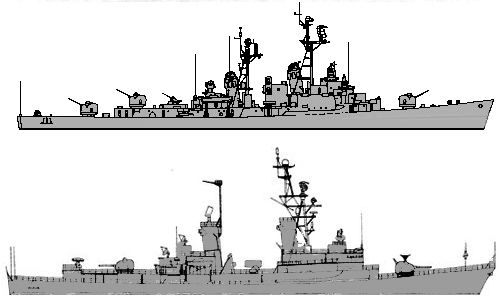
Comparison between the two. It speaks volumes.
The US Navy’s first class of smaller destroyers planned and completed as guided missile ones were authorized in fiscal years 1957–1961 and seen by the Board as enlarged Forrest Shermans with increased freeboard forward. Initial hull numbers were 952–959 following the last Forrest Shermans, but redeignated when commissioned as DDGs 2–9 after previous USS Gyatt (DDG 1) conversion.
Although Congress authorized the first eight as all-gun destroyers preovision was made fo a anti-air missile defense, in order to screenr aircraft carriers. Initial armament comprised the twin-arm (Mark 11) (“one arm bandit”) and Mark 13 Tartar missile launcher replacing the after 5-inch gun as planned on a one-per-mount basis. Overall length jumped by 20 feet to craate an amidship section and fit a Mark 16 ASROC between stacks, a configuration which soon became a “classic” between destroyers and Frigates equipped with this system.
The First with DDG denomination
The denomination indeed had an interesting story by itself: It was established on 23 November 1954 when fleet destroyer Gyatt (DD-712) was the 3rd USN ship converted as a guided-missile armed warship, in the mid-1950s as an experiment. Plans called for a common DD/DDG hull number sequence and DD-712 was reclassified DDG-712 on 1 December 1955 but it was dropped by March 1957 for a separate DDG numeration established for USS Gyatt, renamed DDG-1 on 23 May 1957.
The Gyatt success led to the Charles F. Adams class, with the first eight planned as continuation Forrest Shermans and thus named DD-952 through DD-959. However when the design was finalized, they were reclassified DDG-952 through DDG-959 on 16 August 1956 and after common hull number policy ended, DDG-2 through DDG-9. The Charles F. Adams class was such as success it was decided to convert all Forrest Sherman and four Mitscher-class (22 ships in all) and DDG-31 to DDG-52 were provisioned. But at the end cancellations resulted in only DDG-31 to DDG-36 being used, since conversions were juged too costly for both classes.
Finalization
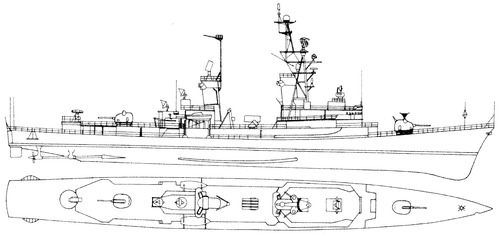
These Tartar-armed missile destroyers were originally designed as modified versions of the Forrest Sherman: A design requirement of the Tartar missile system was that it could replace a single 5-in mounting on a one-for-one basis. The twin 3in/50 nearest the missile launcher be replaced by replenishment-at-sea area for missile replacement, the other by a twin ASW weapon launcher (for the RAT system then in development), and there was to have been a quintuple nest of torpedo tubes between the stacks. However, RAT was abandoned in favour of ASROC, whose eight-round ‘pepperbox’ replaced the originally contemplated long torpedo tubes. These ships also received the usual launching system for light weight ASW torpedoes. Quite soon, it became evident that the new destroyer would have to be lengthened considerably to accommodate the new SQS-23 sonar and an enlarged CIC (for missile control) , and to balance off increased displacement with out a loss of speed.
Design of the class
Hull and general design
The new ships were a repeat of the previous Shermans, as far as the hull shape went. They were a bit larger, for 437 ft (133 m) long overall, 47 ft (14 m) in beam and 15 ft (4.6 m) in draft, versus 418 ft oa by 45 ft and 22 ft. So more lenght and width but less draught. By displacement, they were however larger, at 3,277 tons standard and 4,526 full load, versus 2,800/4,050 tons full load,a sensible difference. The more favourable lenght/width ratio coupled with the lesser draught on the same machinery enabling even a slight increase in top speed. USN engineers arrived at the top pf their game for hull design here. The next Spruance would be completely new animals in that matter, no longer the “sleek racehorse” made until then.
As for the superstructure, the same roughly comparable silhouette was kept, between “two islands” and two tall funnels. However the bridge structure was taller, roomier, and much more “beefier”, but not much heavier as it was an all-aluminum superstructure. This was to alleviate stability issues, added to a clever use of internal spaces and management, plus the use of light alloys for some structural elements, negating any issue with metacentric height, which stayed comparable to the Shermans.
The Adams were also the last US destroyers not though after to carry resident helicopters, something that was integrated on the next Spruance design.
Powerplant
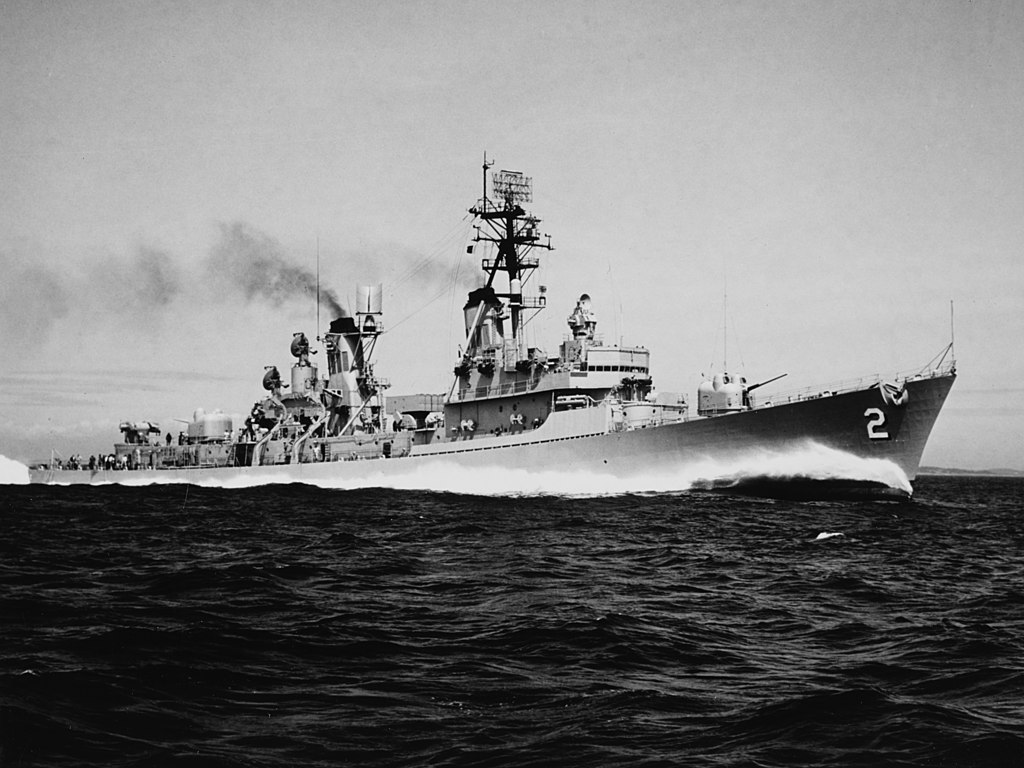
The lead ship in sea trials, 31 August 1960
Since the hull was basically an enlarged version of the Shermans, the same powerplant was used, just upgraded, with two shafts, two sets of steam geared turbines mater to four boilers, both of various types. As customary, the geared turbines were two-stage in order to exhaust first into a HP (High Pressure) stage, for high speed, then a low pressure one (LP) for cruising, with the right coupling to swift to one another. These were the last destroyer so equipped in the USN. The next Spruance class would have gas-turbine propulsion.
Where the ships differed was by their arrangement, which also went with arrangements with their builder:
DDG 2, 3, 7, 8, 10-13 and DDG 20-22 had two sets of General Electric geared steam turbines and 4 Babcock & Wilcox boilers.
DDG 4-6, 9, 14, 23, 24 had two sets of Westinghouse geared steam turbines coupled with 4 Foster Wheeler boilers
DDG 15-19 had two sets of General Electric geared steam turbines again but four Combustion Engineering boilers.
They all shared the same output based on specifications, 70,000 shp for 33 knots.
For endurance, they also had 900 tons of fuel oil in storage in normal conditions, allowing for and endurance of 4500 nautilcal miles (8,300 km) at 20 knots.
To compare, the Forrest Shermans had the same ootput of 70,000 shp (52 MW) but for 32.5 knots and the same range. So no obvious difference between these two generations of ships.
The “game changer” would be the 1970s Spruance class.
Armament
Main Gun
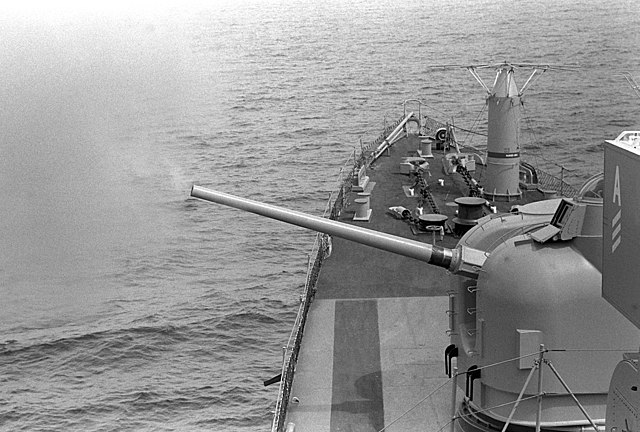
5-in/50 firing from USS Dewey in 1979
The Charles F. Adams class ships were armed with two 5″/54 RF Mark 42 forward and aft. These are coupled with the AN/SPG-53 gun fire control radar. These guns are capable of 40 rpm, muzzle velocity 2,650 ft/s (807.7 m/s) range 25,909 yd (23,691.2 m), Ceiling 51,600 ft (15,727.7 m). The ideal dual-purpose weapon up to that point. In Vietnam, these were routinely used for coastal bombardment with pinpoint accuracy.
Tartar SAM
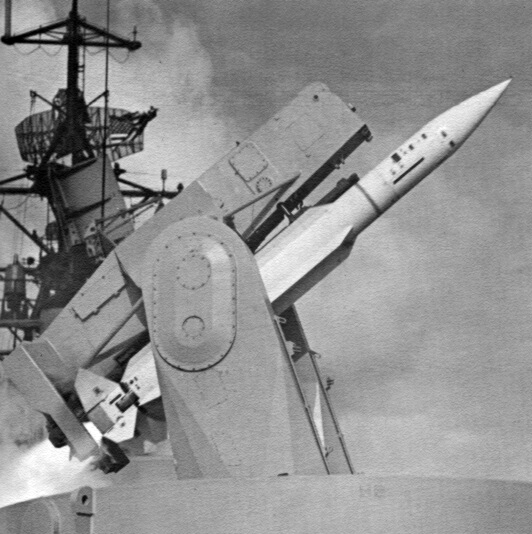
RIM-24 on USS Berkeley (DDG-15)
Unique to these destroyers was the Tartar SAM launcher. The larger Farragut (Coontz) class had Terrier missiles instead. The philosophy was quite different. On the Adams class, each ship had a single system placed at the far aft section of the superstructure, behind the aft 5-in/54 gun. This was a dual launcher, with a vertical reload system, and 42 missiles in store below, perpared and carried by a conveyor belt, with a fully automated reload system. The same systems were installed on three of the modernized Shermans, USS John Paul Jones, Parsons, Decatur, and Somers under SBC 40.
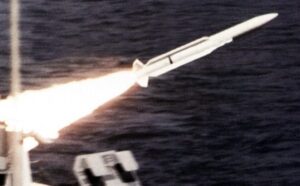 The RIM-24 Tartar was the last and cheaper of the eearly missile range developed by the USN in the 1950s. This was the go-to medium range vector, soon to be adopted by the USN and many NATO allies and partners as well. The goal, unlike the massive Talos and Tartar, was not to shoot down high altitude soviet bombers but deal with incoming, faster and lower altitude jets of all types.
The RIM-24 Tartar was the last and cheaper of the eearly missile range developed by the USN in the 1950s. This was the go-to medium range vector, soon to be adopted by the USN and many NATO allies and partners as well. The goal, unlike the massive Talos and Tartar, was not to shoot down high altitude soviet bombers but deal with incoming, faster and lower altitude jets of all types.
The missile weighted 1,310 lb (590 kg), measured 180 in for 13.5 in in diameter and carried a 130 lb (59 kg) warhead with the same continuous-rod system as the older SAMs. It was powered by a dual thrust, Solid-fuel rocket using Solid Rocket Fuel and able to reach 8.7 nmi (16.1 km; 10.0 mi) on the initial RIM-24A, later ported to 16 nmi (30 km; 18 mi) on the RIM-24B and finally 17.5 nmi (32.4 km; 20.1 mi) on the C versions, and with a ceiling of upt to 65,000 ft, 20 km cilmbing to target at a moderate Mach 1.8. It was guided by SARH.
ASW: RUR-5 ASROC
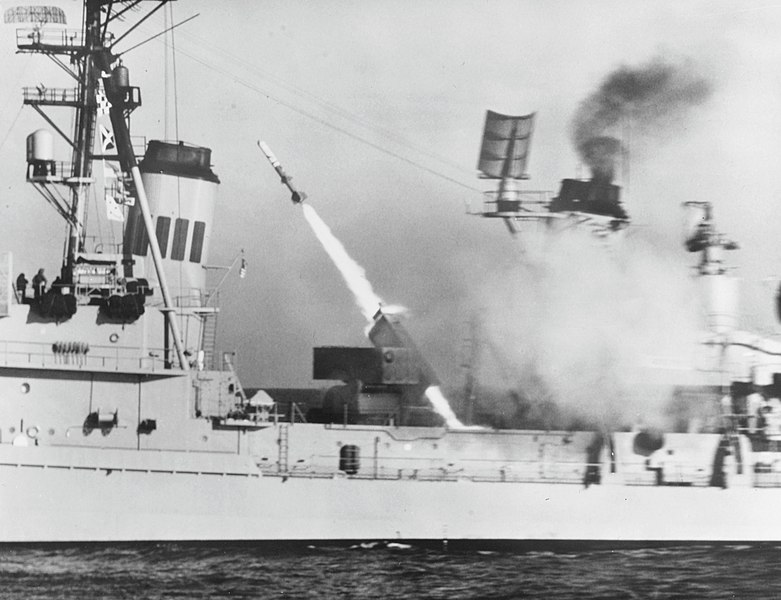
RUR-5 ASROC launched by Charles F. Adams on 18 November 1960, during her weapons trials
They were fitted with an eight-round ASROC launcher between the 5-inch (127 mm) gun and the bridge. USS Farragut (DDG-37) however was the only one with her ASROC magazine mounted behind the launcher. The class was notoriously top-heavy and this atop magazine made it worse made it worse so tha this experiment was stopped and all further nine were completed with magazines relocated down. The system was introduced in 1961, just as the class was completed. It was the go-to missile ASW system in service up to this day. The octuple launcher can be reloaded twice.
ASW Torpedo Tubes
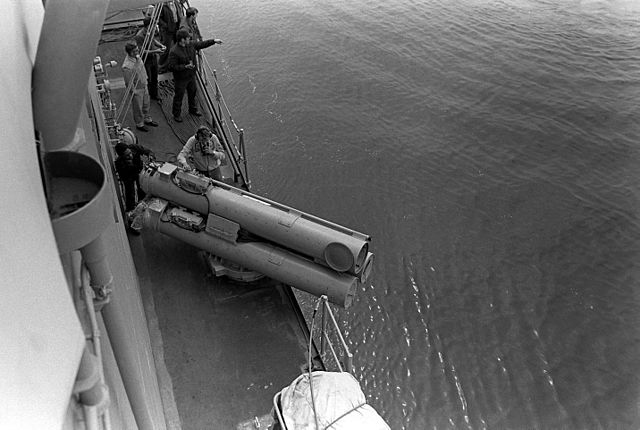
The torpedo launcher is trained on USS Dewey in 1979.
The 324 mm Mark 32 Surface Vessel Torpedo Tubes are ASW triple torpedo launchers installed forward amidship on the upper deck. Developed in the early 1960 they were installed at completion.
The entire launcher weights 2,230 lb (1,010 kg) in fiberglass-metal, enabling an installation practically anywhere, added to its compact size. It was able to fire at first the 12.75-inch (324 mm) Mark 44. In later upgrades the Mark 46, 50 or 54 could be fitted. The Mark 44 is the “universal” cold war acoustic ASW torpedo. It was designed to be airbone as well as shipborne. Weighting 432 pounds (196 kg) for just 8.2 feet (2.5 m) and a diameter of 12.75 inches (32.4 cm) it had a 123 metres per second (400 ft/s) initial velocity, with electric drive 30 hp (22 kW) up to 30 knots (56 km/h; 35 mph).
The Mark 44 carries a Mk 101 Mod 0, HBX-3 75 pounds (34 kg) warhead with a Mk 19 type Mod 12 contact exploder. It is an active guidance model using Helix search from 123 metres (135 yd) to 3.4 miles (5.5 km) and down to 1,000 yards (910 m) mas depth.
Sensors
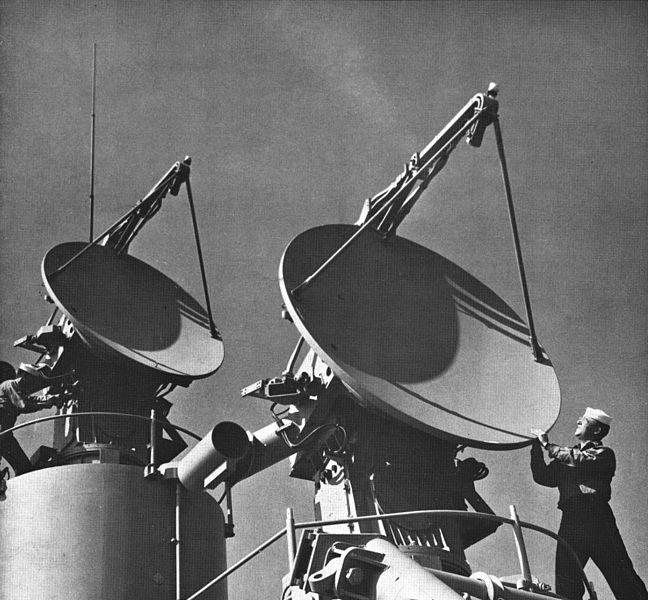
SPG-51 radars on Charles F. Adams
AN/SPS-10 surface search RADAR: 1959 2D, C Band PRF 650 Hz bw 1.9° × 16° pw 1.3 µs rated 280 kW
AN/SPS-37 air search radar: 1958 2D VHF PRF 300 Hz bw 20° Range 500 km (270 nmi) rated 250 kW
AN/SPS-39 air search 3D radar: 1960 3D S Band PRF 1850 Hz bw 1.1° × 2.25° pw 4 µs Range 296 km (160 nmi) rated 1 MW
2x AN/SPG-51 Tartar fire control radars: Pulse-Doppler radar 10.5 GHZ/5.825 GHz PRF 4100/9600-16700 pps bw 0.9°/1.6° pw 2.1-3.2 μs rated for 4000/1600 W
AN/SPG-53 gun fire control radar: Gun fire-control range 120,000 yd (59 nmi) 3D data, rated 250kW
AN/SQS-23 SONAR: For the Mk32 Torpedo Tubes, 5HZ, 20ft transducer, 10,000 yds range
Onboard Helicopters
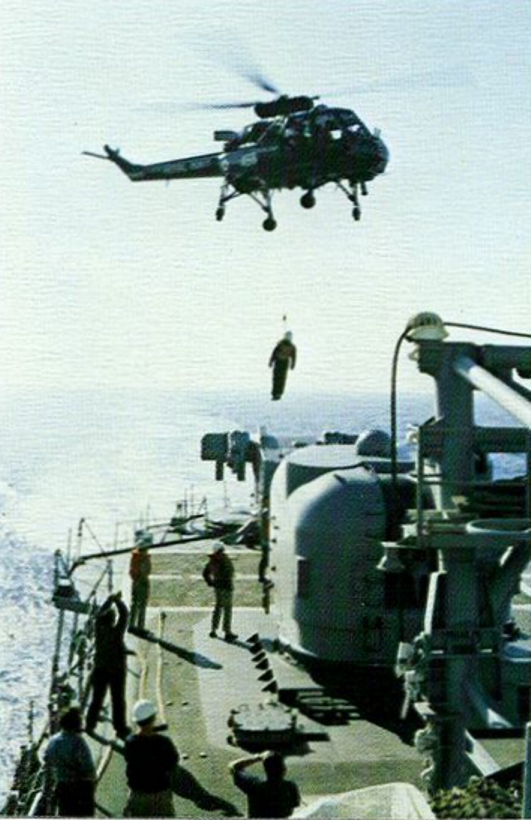
A Westland Wasp hovers a US personal over USS Charles F. Adams in 1972
There was no hangar (last destroyer not to have one) and thus no permanent park, albeit the stern was managed to receive a small and narrow pad. It is likely according to rare photos they occasionally used a Kaman SH2 Seasprite for ASW patrols when deployed in Vietnam.
Construction & Assessment
The class was named after U.S. diplomat who played an important role in keeping Britain neutral during the U.S. Civil War. Before the Spruance class, they were the longest-running serie (and best exported) class of US destroyer, after the modernized FRAM-I/II. Twenty-nine ships represented a leap forward in quantity also (although in the end only 23 went in US service), as it was ten more than the Forrest Sherman class for example, and the largest missile destroyer class in the world before the Spruance (31 ships) not even counting the Kidd class, and a tendency confirmed with the Arleigh Burke (90 planned in 8 blocks, 70 delivered). The latter is a wartime figure but reflects the needs of the Navy to built around modularity to enable endless upgrades.
The Charles F. Adams construction run was short however: Starting in 1958, it went on until 1964 when was completed the last of the serie, the USS Wadell (Comp. August 1964). They proved adaptable enough however to have a long career, probably more than most destroyers in the USN, maintained active until 1989-92 so to the end of the cold war, and seeing all the conflicts from the 1960s to the Gulf War, as well as seeing active wartime service notably in Vietnam.
This was due to their nature, as they were large enough for future upgrades, were really designed as missile cruisers from the start and not as an afterthought, and the general configuration and size made them perfectly apt to be upgraded multiple times in all areas, from missile armament to electronics. They also came with the new generation of ASW and SAM weaponry, which stayed relevant until the late 1980s in US inventory.
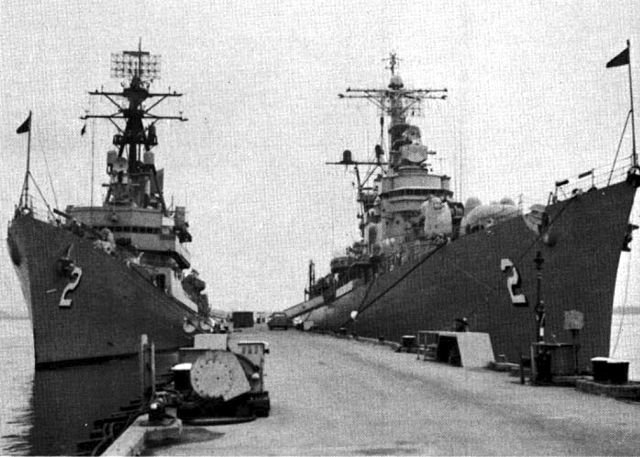
Charles F. Adams and Mitscher moored at Charleston pier, 1962
Their general conception thus seduced West Germany, which nedeed to replace their conventional Fletcher-class “Zerstörer” series of the 1950s with the three ships of the Lütjens class which were launched in 1965 and among the very last built. The reasoning also hit Australia, after long arbitrating about their own serie, with the Perth class, very last built: HMS Brisbane, the third, started on 15 February 1965 was only completed on 24 January 1968. They lived longer than the originals, being retired in 1999-2001. The Bundesmarine retired them in 2003 and renounced to missile destroyers afterwards, with the end of the cold war and constant upgrades in capabilities of large frigates.
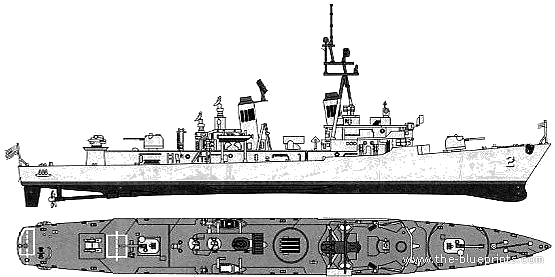
Construction
These ships were ordered to six yards in all, between the west and east coasts: Bath Iron Works (Maine), New York Shipbuilding Corporation (New Jersey), Defoe Shipbuilding Company (Michigan), Todd Pacific Shipyards (Washington), Avondale Marine (Louisiana), and Puget Sound Bridge and Dredging Company (California)
USS Charles F. Adams was built at Bath Iron Works, the first laid down, on 16 June 1958, launched on 8 September 1959, comp. on 10 September 1960.
John King was laid down on 25 August 1958, launched 30 January 1960, Lawrence on 27 October 1958 and launched 27 February 1960. The last, USS Waddell (DDG-24 was laid down on 6 February 1962 and launched on 26 February 1963, she was also the last commissioned, on 28 August 1964 and like xxx saw extra service as Nearchos (D219), ending as target.
Foreign Adams: Greece, Australia and Germany
 Kimon class (1991)
Kimon class (1991)
Kimon, Formion, Nearchos, Themistoklis (DD 218-DD 221)
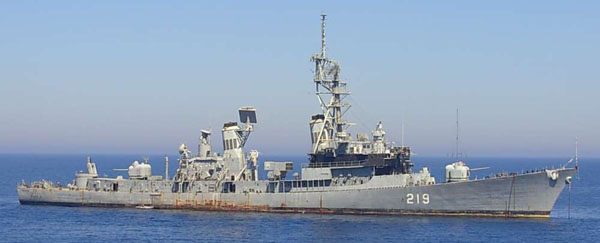
In 1991, the USN, having just decommissioned USS Semmes DDG-18, had the opportunity of an arms deal in favor of Greece concluded that same year. She had a quick refreshing and was sent like four others in 1991-92 to the Hellenikon Nautikon for extra years of service. USS Semmes, the first one and lead ship of the new class, was sold to Greece on 13 September 1991 and renamed Kimon. She was decommissioned on 17 June 2004 and placed in reserve at Souda Bay, Crete, until scrapped fall 2006. The second one was USS Waddell (DDG-24), decomm. on 1 October 1992 and Sold to Greece, recommissioned as Nearchos (D219), decommissioned from the Greek Navy on 3 June 2003 and sunk as target on 29 May 2006. The third was Formion (D220) formerly USS Joseph Strauss and the fourth Themistoklis (D221) formerly USS Berkeley.
USS Richard E. Byrd was also sold to Greece in late 1990 but for parts, she was never commissioned.
They were the First Hellenic missile destroyers, not counting ASROC on previous classes. The ex DDG-18 was renumbered DD-218 in Greek service, leased from 13 September 1991, the other three came from San Diego and were acquired in 1/10/1992 but recommissioned on 30 April 1994. It is not sure that they were equipped with Harpoon missiles, possibly transferred later. They were in 1995 prospects to upgrade their electronics, with a new combat system, sonar and SAM but it was never realized. Instead, they were scrapped in the 2004-2005s, after a ten year service.
In addition Richard E. Byrd (DDG-23) was sold for parts (never recommissioned) and ended as target.
 Perth class Missile Destroyers (1963)
Perth class Missile Destroyers (1963)
HMAS Perth, Hobart, Brisbane

HMAS Hobart off California, 1992
After evaluating the prospect of acquiring British missile destroyers, such as the County class, destroyer (program 1961) or develop a new one in collaboration with UK, the Australian government decided that the US destroyers of the Charles F Adams were more suitable for their tasks. Two DDGs at first were ordered in January 1962 to Defoe SB yard, and a third one year later. They were almost identical to the original, sparing R&D costs, save for an Ikara ASWRL replacing the ASROC, with its own deckhouse built to house the ammo reloads and control.There were two launchers, single-arm, port and starboard. In standard they were equipped with the Tartar. Launched in 1963, 64 and 1966, they were completed in 1965-67. USS Goldsborough (DDG-20) decomm. on 29 April 1993 was also Sold to Australia as a parts hulk, scrapped later.
In 1974-79 they were modernized, swapping their Tartar for a more modern SM-1 SAM and associated upgraded FCS, plus the gun mountings Mark 10. Last modernization came in 1985-91, as they received all-upgraded electronics: SPG-53A radars, SQQ-23F sonar, ERD-4 ECM suite, NCDS CCS. With this, they received two Harpoon SSM canisters and two Phalanx CIWS before operating in the gulf war. They also received later an SPS-40D, SPG-53F, two fittings for Mk 90 radars, the SQS-23KL sonar, WLR-1H, ULQ-6 ECM suites, two SRBOC decoy RL, SLQ-25A Nixie torpedo decoy. They were discarded in 1999, 2000 and 2005 respectively, the last one scuttled to create an artificial reef.
 Lütjens class (1965)
Lütjens class (1965)
Lütjens, Mölders, Rommel

BDMS Rommel, 1970
Called the class 103/103A/103B or more commonly Lütjens class, these were the main guided missile destroyers of the Bundesmarine (German Navy). The ships ships were built in 1966-1970 in the United States for the Federal Republic of Germany, based on the the American Charles F. Adams class. This was a sub-class called Mod.14 (Tartar-Guided Missile Destroyers SCB 155). At that time they were 10 years old, within which many defaults and limitations has been ironed out. Lütjens referred to the German Kriegsmarine great admiral Gunther Lütjens, Werner Mölders about a Luftwaffe ace, and Rommel of course referred to the German General of North Africa fame, Erwin Rommel. The destroyers served until the 1990s, assuming the bulk of the Bundesmarine defence during the late cold war era.
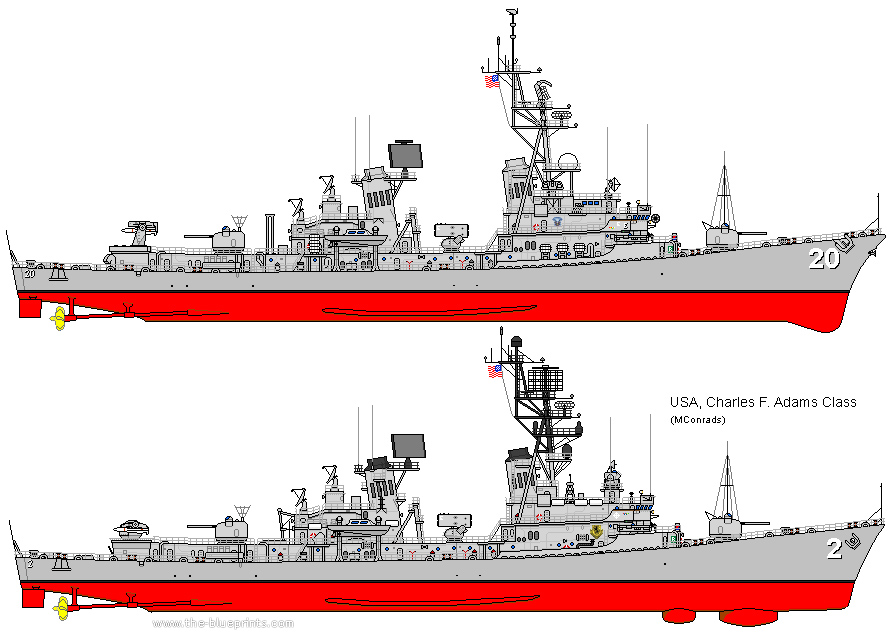
DD20 and DD20 differences. Shipbucket’s MConrad profiles via the blueprints.com
placeholder
HD profile to come in the future
⚙ specifications |
|
| Displacement | 4,167 lt standard, 5,648 lt deep load |
| Dimensions | 512 ft 6 in x 52 ft 4 in x 17 ft 9 in (156.2 x 16 x 5.4 m) |
| Propulsion | 2 shafts GS turbines, 4 WT FD B&W SH Boilers 85,000 shp (63,000 kW) |
| Speed | 32 knots (59 km/h; 37 mph) as designed |
| Range | 5,000 nautical miles (9,300 km; 5,800 mi) at 20 knots |
| Armament | 1×2 Mk10 Terrier SAM, 2x 5-in/54 gun, ASROC, 2×3 Mk 32 TTs, see notes. |
| Sensors | AN/SPS-10, 48, 49, 53 Gun FCR, 2x AN/SPG-55 Missile FCR, AN/SQS-23 SONAR |
| Crew | 23 officers, 337 enlisted men |
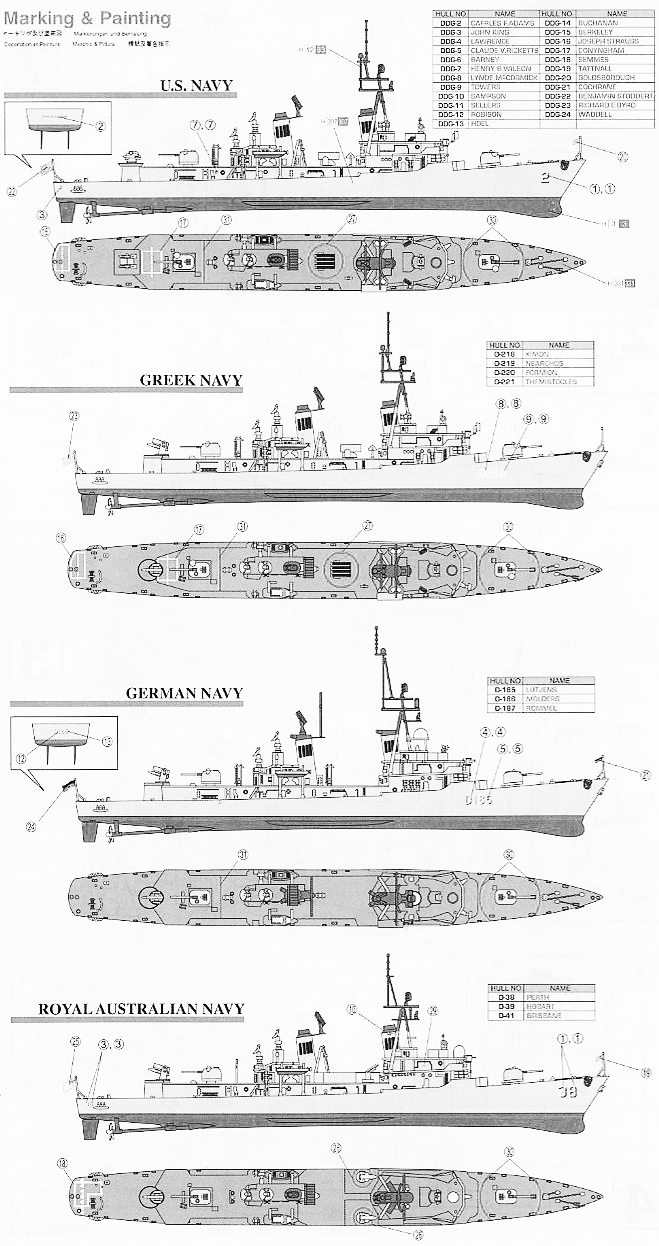
Liveries and difference between US, German, Australian ships (model kit artbox)
Upgrades
Although cutting-edge in 1958, the mid-1970s and the gap repsented by the new Spruance class did not shed positive light on the Charles F. Adams-class destroyers; They were simply overwhelmed by the technological advance in missiles and face the choice of scrapyard or intensive modernization, in the extent that was possible. The U.S. Navy worked out a program to keep these ships relevant until at least the mid-1980s called the New Threat Upgrade (NTU). This was complete overhaul of their sensor, weaponry and communications system in the frame of the actual hulls. They received improved electronic warfare capability notably by the installation of the AN/SLQ-32(V)2 EW Suite.
Their new combat system also included the following:
-MK86 Gun Fire Control System with AN/SPQ-9 radar
-Hughes AN/SPS-52C 3D radar
-AN/SPG-51C Digital Fire Control Radars
-Naval Tactical Data System (NTDS).
-Harpoon anti-ship missiles canisters in place of the MK-11/13 Tartar.
There were several modifications during the construction of the class. FY59 and later ships (DDG-15 DDG-24) had single-rather than twin-arm Tartar launchers for greater reliability; FY60 and FY61 units (DDG 20-DDG 24) had bow mounted sonars, a change evident from the bow location of their anchors. Australia and West Germany both purchased near-sisters : the Australian DDG 25-DDG 27 had Ikara instead of ASROC amidships, and the West German DDG 28 – DDG 30 had ‘Macks’.
Some ships were refitted with + round ASROC reload magazines starboard alongside the forward funnel. These ships were completed with out computer combat direction sysems. However, by 1971 a new smaller central computer (UYK-7) made possible a compact version of NTDS. It was to have been installed in the entire class (and also in the DDG 31s), but funds were short, and only DDG 9, 12, 15, and 21 were fitted. All were completed by 1973. The system was called Junior Participating Tactical Data System JPTDS); it was roughly equivalent to the French SENIT and to the German SATIR. associated
The Weapons Direction System is Mk.13. Programmes for modernisation were complicated by the very tight design of these ships. Thus a program which was to have begun with D-3 in FY80 was abandoned under Congressional pressure when the projected cost per ship rose to $221, and the program was already cut to ten ship and instead, DDG 15 to DDG 24 w modernised as part of their reefits, with work was spread over overhauls, for a total of two year. The first in Philadelphia N Yd startedin 1981, USS Goldsborough and B Stoddert have also been funded by early 1983. In the case of the former, the combat systems upgrade ried out in the first overhaul with a hull and machinery (in sonar) upgrade scheduled for ond overhaul about two years.
The major external changes evivdent are:
-The installation of the Mk.86 gan missile fire control system, which adds a third full missile control channel forward (the earlier SPG-53 had a secondary missile control capability)
-The installation of SLQ-32 and SLQ-20 countermeasures in place of the earlier ULQ-6B
-The installation of new radars (SPS-40C/D in place of the less reliable SPS-40B, SPS-52C in place of SPS-39, and LN-66 for navigation).
More significantly, the ships are fitted with a three-computer NTDS and with an integrated combat system (SYS-1).
Countermeasures capability is also increased by the installation of Super Rapid Blooming Offboard Chaff (BOC).
While in service, was this increased.
Electronic equipment was upgraded, air conditioning compressor capacity increased from 140 to 225 tons, the service turbo-generator capacity is increased also by 750kW. Modernised ships have their SQS-23 systems upgraded to two-dome SQQ-23 configuration. All ships had their Mk 11 or Mk 13 missile launchers modified to accommodate Harpoon (typically four in a Mk 11, six in a Mk 13). In modernised ships, SPS-40 generally replaced SPS-37 (although DDG 5 still had her SPS-37 as late as October 1988) and SLQ-32/SRBOC was added. SPS-39A radars had planar array antennas fitted (it is not clear whether SPS-52 replaced SPS-39).
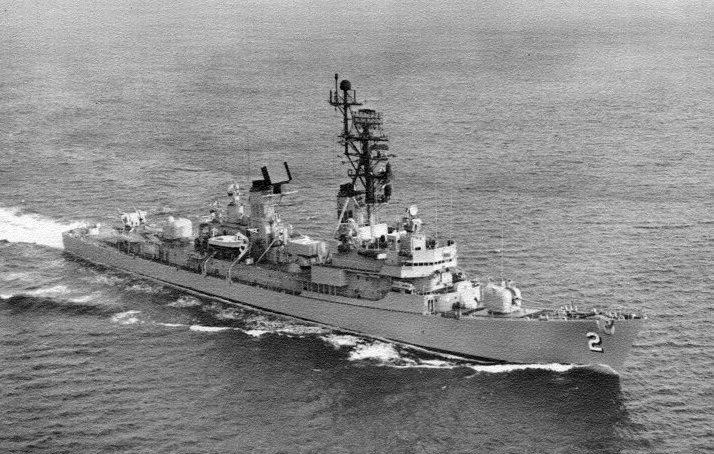
Charles F. Adams in 1973
The Reagan Administration wanted however to accelerate the development of the new AEGIS Ticonderoga-class guided-missile cruisers and replace the Spruances by the new Arleigh Burke-class which also had the Aegis Combat System and considered way more interesting than the NTU-upgrade program. AEGIS was also te be applied at the time on elderly cruiser nuclear-powered cruisers of the California/Virgina classes. Thus, this called for budget cuts. And only three of Charles F. Adams-class, USS Tattnall, Goldsborough, and Benjamin Stoddert would receive the full upgrade while other were only partially modernized notably AN/SLQ-32 and Harpoon Missiles, and they were scheduled for replacement as a per-unit basis by the new Arleigh Burke class in the 1990s.
The last decommissioned was USS Goldsborough, on 29 April 1993. But as said above, both the Australian and German navies kept them until 2003, and some were transferred to the Hellenic Navy, enjoying more years of service.
Some in the navy wanted to preserve at least one ship of the class. The lead ship, USS Charles F. Adams was in fact chosen to be preserved as a museum ship in 2018, but no funding was appropriated and the ship was returned to the USN which had her BU in 2020. Mölders was also to be converted as a museum ship, but this also did not worked. She was demilitarized, used as a target in the Baltic Sea and by 2006, mothballed in Wilhelmshaven until 2011, sold for scrap by Aliağa yard, Turkish Aegean coast by 2012.
Read More
Books
J. Gardiner Conway’s all the world’s fighting ships 1947-95
Blackman, Raymond V. B. Jane’s Fighting Ships (1970/71)
Polmar, Norman “The U.S. Navy: Shipboard Radars” United States Naval Institute Proceedings 1978
Polmar, Norman “The U.S. Navy: Sonars, Part 1” United States Naval Institute Proceedings 1981
Friedman, Norman (1982). U.S. Destroyers: An Illustrated Design History. NIP
Links
https://www.semmesddg18.org/
http://navypedia.org/ships/usa/us_dd_c_f_adams.htm
https://en.wikipedia.org/wiki/Charles_F._Adams-class_destroyer
https://www.seaforces.org/usnships/ddg/Charles-F-Adams-class.htm
https://www.globalsecurity.org/military/systems/ship/ddg-2-schem.htm
https://www.history.navy.mil/our-collections/photography/us-navy-ships/alphabetical-listing/c/uss-charles-f–adams–ddg-2-0.html
https://www.globalsecurity.org/military/systems/ship/ddg-2.htm
https://destroyerhistory.org/coldwar/charlesfadamsclass/
https://www.usni.org/magazines/naval-history-magazine/1995/april/part-iii-matter-class
https://web.archive.org/web/20120320234914/http://www.hmasperth.com.au/
https://www.jaxnavalmuseum.org/uss-charles-f-adams-memorial/
https://web.archive.org/web/20100330103919/http://adamsclassddgvets.org/
https://web.archive.org/web/20110725231649/http://destroyerhistory.org/coldwar/charlesfadamsclass/
https://commons.wikimedia.org/wiki/Category:Charles_F._Adams_class_destroyers
The_Impact_of_the Charles_F_Adams_Class_Guided_Missile_RAN
Model Kits
Original blueprints on ebay.com
Videos
USS Buchanan (DDG-14) – Capabilities of Charles F. Adams Class Guided Missile Destroyers
Model Kits
The category is relatively popular as in the 1960s model kits were still all the rage. At 1:350 there was the Iron Shipwrights kit and even the French DDG-22 USS Benjamin Stoddert by L’Arsenal also at 1:350 and White Ensign Models (same). But 1:700 was really the master scale like so many ships for collectioners, so let’s cite Dragon, Pit-road, Shanghai Dragon, Revell, BigBlueBoy upgrade kit for dragon kits, Pit-Road photo-etch parts and the massive 1:96 USS Waddell DDG-24 or Charles F. Adams by The Scale Shipyard detail set in resin, for radio-command models.
General query on scalemates
Career of the Adams class
 USS Charles F. Adams (DDG-2)
USS Charles F. Adams (DDG-2)
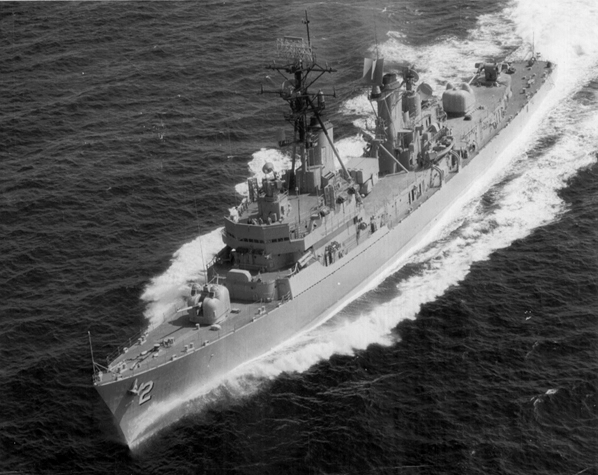
Charles F. Adams during her sea trials in 1960
Following commissioning, USS Charles F. Adams took part in an Appolo mission, Mercury 8. She took part in the Cuban Missile Crisis’s quarantine forces. By July 1969, she left home port Charleston for Mayport. On 19 November 1980 under Command of Joseph F. McCarton, was screened USS Independence in the Arabian Sea and Indian Ocean. Later she was in Australia (Bunbury) in February 1981.
USS Charles F. Adams was decommissioned, stricken on 1 August 1990. She was not saved as a museum ship while in the Donation Hold at the Philadelphia Naval Shipyard, despite an attempt by the Saginaw Valley Naval Ship Museum (Michigan) due to cost issue. By 2008 another was attempted by the Adams Class Veteran’s Association and Jacksonville Historic Naval Ship Association with an application delivered on 31 March 2008. By 2010, the $300,000 bill to tow her to Jacksonville and $3 million for repair/restoration plus $5 million for the pier was never approached when cancelled By late 2013. By 27 August 2014 the City Council approved a lease of the riverfront, authorized to manage the project, expecting the ship moved in 2015 but it was abandoned by December 2018 due to the reluctance of the Navy, preferring demolition, which was done from September 2020 in Brownsville, Texas, complete in July 2021.
 USS John King (DDG-3)
USS John King (DDG-3)
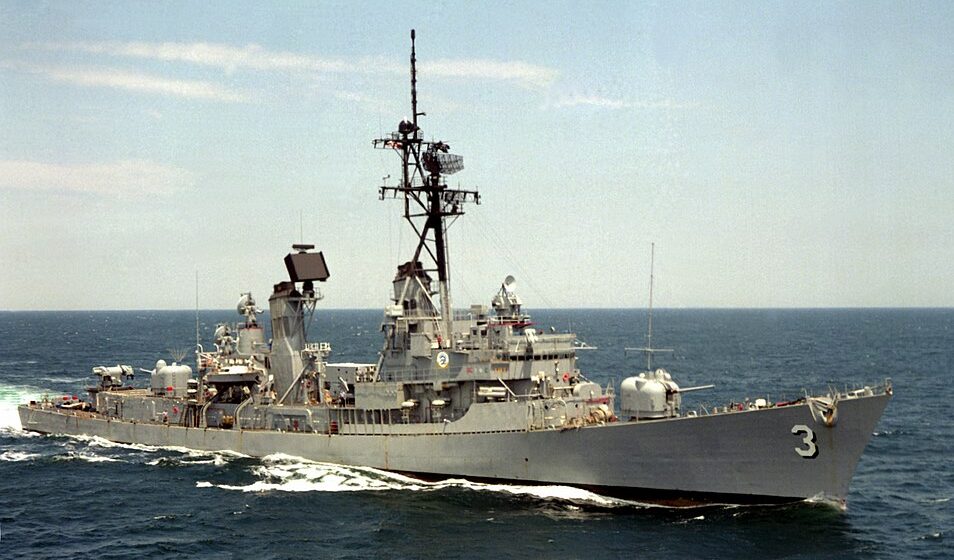
USS John King was built at Bath Iron Works, Maine, commissioned on 4 February 1961 with Comdr. Albert M. Sackett commanding. She was reclassified twice, and then DDG-3 on 26 June 1957, and after sea trials and her shakedown, then post-fixes and availability followed by qualification drills. Weapons tests were performed later on the East Coast and she was homeported to Norfolk by September 1961. On 27 November she made her first operatioal deployment to England and Northern Europe and by January 1962 she headed for the Mediterranean, 6th Fleet and back to Norfolk by April 1962 for more fire drills in the Caribbean and being visited in Washington on 10 July 1962 for 4-days by Senators and Congressmen led by the Secretary of the Navy Fred Korth, which admired this brand new destroyer.
She had a small refit at Norfolk Navy Yard by October 1962n and she was ordered to take part in the Cuban blockade (Cuban Missile Crisis) by October 1962. She enforced the quarantine with her repairs barely made, arriving on 6 November. Afterwards she trained with USS Enterprise (CVN-65) and was back to Norfolk on 8 December. She made her 2nd Med TOD from 6 February 1963. She visited Kiel, on 23 June 1963 and was back home on July. The next year were spend training home, between the Virginia Capes and Caribbean, and with the ASW school at Key West by April 1964.
Her 3rd Med TOD started on 3 August 1964 notably to operate off Cyprus.
She was in Norfolk on 29 January 1965, and made her 4th Med TOD from 14 October, 4 months and back in March 1966. In July she took part in NATO Exercise “Straight Laced.” She made her 6th Med TOD by 10 January 1967, Western Mediterranean and back in May, then overhauled by June 1967. She would not be deployed to Vietnam.
The 1970-80s repeated the same routine, cut by NATO exercises and Atlantic Fleet operations. By 1982 off Beirut in Lebanon she provided gunfire support to US. Marines as her only active combat deployment. She was eventually decommissioned on 30 March 1990, stricken on 12 January 1993, sold in 1999.
 USS Lawrence (DDG-4)
USS Lawrence (DDG-4)
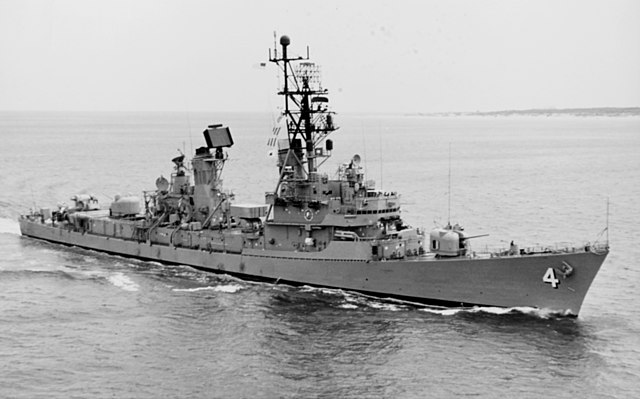
USS Lawrence was built at New York Shipbuilding Corp. Camden, commissioned on 6 January 1962. Following trials and a unusual shakedown cruise on the Great Lakes, she was homeported to Norfolk, and after her weapnons qualifications, she was deployed with Task Group 136.1, screening USS USS Canberra (CAG-2), Newport News (CA-148), and three guided-missile destroyers plus twelve escorts deployed north of Cuba on 24 October 1962 as the crisis started since two days. On 26 October 1962, USS Lawrence and MacDonough shadowed the Soviet tanker MT Grozny. The crisis was defused two days later.
She was prepared in Norfolk on 6 December for her first med TOD, with the Mediterranean 6th fleet, departing on 6 February 1963, until July. She made a 2nd between April and August 1964, followed by an overhaul in Norfolk, and made four more cruises on 24 August-17 December 1965, a North Atlantic NATO exercise (3 August 1966-5 September 1966), Med TOD (27 September 1966-1 February 1967 and with the 6th Fleet cruise on 10 January-4 May 1968, rescuing the crew of the merchant New Meadow off Crete. She made two more Med TODs in 1969 and 1971, before being sent for her first WestPac depoyment from 1972 to 1973. This was the last Vietnam engagement year (direct) for US troops and she provided naval gunfire support and as plane guard, rescued downed aviators at Yankee Station? She was once visited by the CNO (Chief of Naval Operations) and Secretary of the Navy.
While she was transiting via the Panama canal at her return, her sister ships was sabotaged by a crewman dropping a large wrench into the main reduction gear shaft adn she was sent to San Diego for repairs, replaced by USS Lawrence, which took part in Operation Linebacker. She soon earned the moniker “Leapin Larry” and was awarded a Meritorious Unit Commendation.
This was her only Westpack deployments and afterwards she resumed her Sixth Fleet operations in 1977, 1978, 1979, with a brief visit into the Black Sea. She also circumnavigated Africa to enter the Indian Ocean and Persian Gulf in 1974. She made three more od such deployment in 1980, 1983 to 1984.
In 1986, she circumnavigated South America (Operation Unitas XVII) as the flagship for DesRon 26. She was overhauled several times but only partially modernized.
She was decommissioned on 30 March 1990, stricken on 16 May, sold on 15 April 1994 and 10 February 1999 as the first scrapyard became bankrupt.
 USS Claude V. Ricketts (DDG-)
USS Claude V. Ricketts (DDG-)
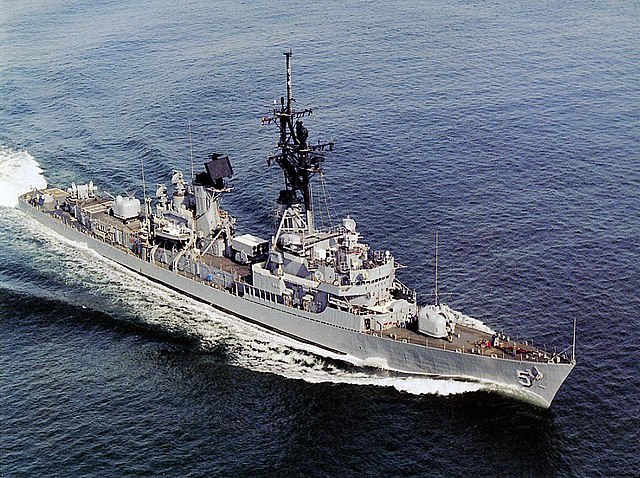
USS Claude V. Ricketts (DDG-5) Underway off the Virginia Capes, 1986. Official U.S. Navy Photograph, from the collections of the Naval History and Heritage Command.
DD-955, and later DDG-5 the ship was built at New York Shipbuilding Corp. and commissioned as USS Biddle on 5 May 1962 while in Philadelphia for fitting out and renamed as Claude V. Ricketts on 28 July 1964 to honor the WW2 Admiral just died on 6 July 1964.
After sea trials and shakedown she started her weapons qualifications along the east coast with the 2nd fleet and she operated off Cuba before the Cuban Missile Crisis. She made her first Mediterranean Sea tour (Med TOD) fall 1963, homeported to Norfolk. By June 1964- fall 1965 she took part in a mixed-manning experiment testing the Multilateral Force (MLF). She had aboard 10 officers and 164 crew from the US Navy alone, while the remainder came from West Germany, Italy, Greece, UK, Netherlands, and Turkey as a NATO cooperation. The MLF was never created, but Secretary of the Navy Paul Nitze estomated it was successful. She earned a Navy Unit Commendation for this.
Next she made her second Med TOD and others from 1966 to 1973 punctuated with northern European cruises, notably one by July 1972. By mid-1974 she underwent an overhaul at Norfolk Naval Shipyar, making her refresher training in the Caribbean in March-May 1975.
In July 1975, during her near-yearly Med TOD she came to the rescue of USS Belknap (CG-26) colliding with USS John F. Kennedy (CV-67) during the night of 22 November 1975. The cruiser was burning and he destroyer came alongside and with her crew and pumps she fough the blaze for 7 hours, while hit by fragments from exploding ammunition. She would earn a Navy Unit Commendation for this.
In 1976 she toured Africa. On October 4, she made a new Med TOD stopping in Kenya to (13th independence anniversary) followed by six-week operation with the Brazilian Navy. Until October 1978 she was overhauled, back to Norfolk in April 1979 after refresher training, trials and sent to the Mediterranean for seven months (US Middle East Force, 6th fleet) by September, visiting Karachi, a,nd scrambled to the Persian gulf during the Iran hostage crisis. She was there with USS La Salle (AGF-3), staying for 72 days and stopping at Bahrain when back to the Mediterranean by February 1980 then Norfolk, earning a second Navy Expeditionary Medal. She cruised Northern Europe in 1981, Standing Naval Force Atlantic, making many stops and back home by June.
By late 1983-early 1984 she was deployed off the coast of Lebanon after the Beirut barracks bombing. She resumed her Med TOD by late 1987 and was back home by March 1988.
She was decommissioned on 31 October 1989, stricken on 1 June 1990, sold on 15 April 1994, repossessed and resold on 5 December 2001.
 USS Barney (DDG-6)
USS Barney (DDG-6)
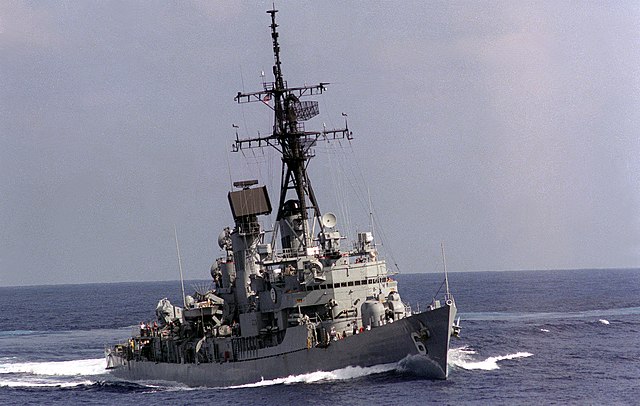
USS Barney was built at the New York Shipbuilding Corp. Camden, commissioned on 11 August 1962 and after outfitting sea trials on 27 September, pre-shakedown qualification tests, missile firings ans homeported at Norfolk on 8 December. Her shakedown cruise done she had a post shakedown overhaul and started operations this simmer with the 2nd Fleet followed by her 1st Med TOD (5-month) with the 6th Fleet. By September 1964, she underwent a series of NATO exercises. Her 2nd Med TOD followed by February 1965 and participated in Operation “Fairgame III.” In 1966 she trained at Key West ASW school and by March, started her second overhaul at Norfolk.
She departed by February 1967 to take part in the Vietnam War, only WestPack deployment, for seven months. She was homeported provisionally to Subic Bay in the Philippines. There, she was sea air rescue controller, and made gunnery support missions in North and South Vietnam, notably sometimes shelled by enemy shore batteries. She once had a crew member wounded by a shell fragment.
After stopping at Okinawa she was back to Norfolk bt September 1967.
By March 1968 she made her 3rd Med TOD with the 6th Fleet. She alternated with 2d Fleet operations and was in West Indian waters by January 1969. By April, she made her 4th Med TOD for a trilateral ASW exercise centered around USS Wasp with the Spanish and Portuguese navies. By May she was in Portsmouth for the 20th anniversary of NATO. In the Med, she took part in a bilateral ASW exercise with the French Navy and an amphibious exercise in Sardinia eventually relieved by USS Stickell in Majorca. An overhaul followed.
In 1970 she took part in the Jordanian crisis with TG 60.1 by October (USS John F. Kennedy) until November. For her 1972 Med TOD she acted as DesRon 2 flagship. She would return to John F. Kennedy TG. she took part in another bilateral exercise with the Royal Navy. In 1973 she was to be redeployed to Vietnam but this was cancelled. Instead she had a power plant conversion from 600 PSI to 1200 PSI boilers, with change of piping and conversion to Navy distillate oil. This was over by the spring of 1973. She later joined NATO’s Standing Naval Force, Atlantic.
One exercize took her in the Baltic and Arctic Circle. While in the Kategat her propellers struck bottom at 21-24 knots, with some flooding in her aft engineroom. She was repaired at sea and could resume her trip at 14 knots until the end of her deployment. By 5 December she went to Norfolk and was repaured until the first three months of 1974. She was not upgraded with the AN/SQQ-23PAIR sonar retrofit. This was followed by an overhaul until 24 February 1975. She resumed Atlantic Fleet operations in 1976 and another Med TOD in 1977, then in 1978, notably off East Africa and Persian Gulf ports.
She made another Med TOD from November 1980, and joined the Middle East Force until 22 February 1981. She would made another such deployment in 1984–85 and by 1987–1988 made another Med TOD with large multilateral NATO forces and crews. Later back home she made a short Navy/Coast Guard Narcotic Interdiction cruise and final one by August 1989 then last Med TOD on 1989–1990. She was decommissioned on 17 December 1990, stricken on 20 November 1992, sold on 15 April 1994, resold on 22 February 2006.
 USS Henry B. Wilson (DDG-7)
USS Henry B. Wilson (DDG-7)
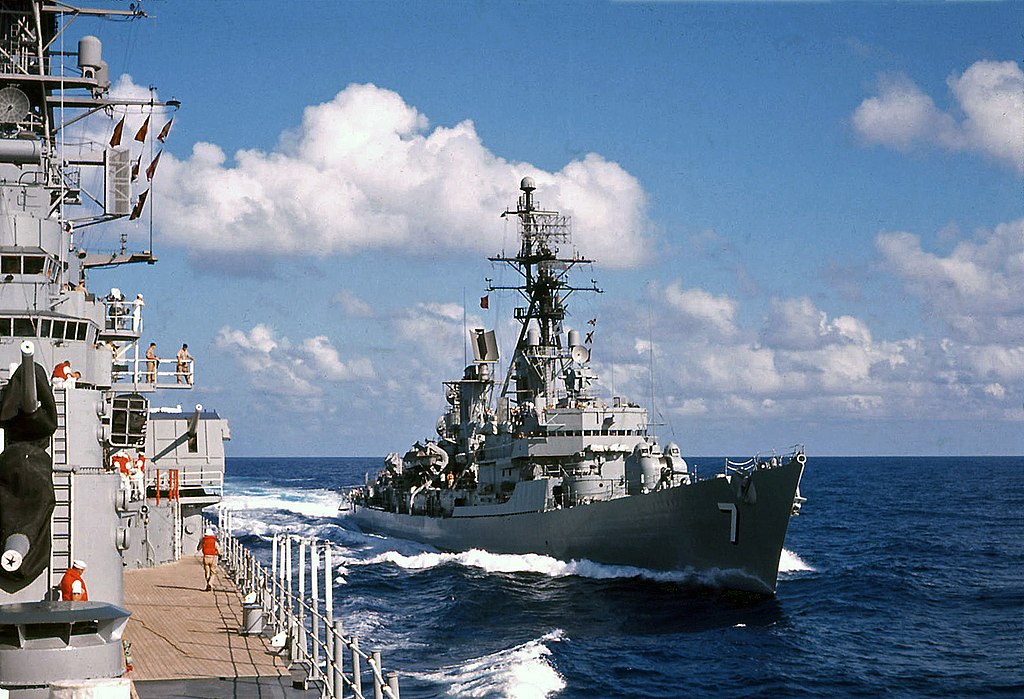
USS WILSON (DDG-7)
USS Henry B. Wilson was built at Defoe Shipbuilding Company, Bay City, Michigan, commissioned on 17 December 1960. She was the first built there and largest also on the Great Lakes and to roam the Saint Lawrence River to the the Atlantic Ocean after her sea trials and shakedown in the Caribbean by May 1961 she was homeported to San Diego. She started her first WestPac deployment on 6 January 1962 and first ships with Tartar missiles in the area, homeported to Yokosuka. Next year she trained along the California coast until late 1963, and screened USS Kitty Hawk when back with the 7th Fleet ad par tof a mobile peacekeeping fleet. She started her 3rd WestPac from 4 June 1965, flagship DesRon 21 in the Philippines, air defense picket in the Gulf of Tonkin as well as gunnery support, escort for USS Midway.
Her 4th WestPac started on 5 November 1966. Picket duty and South China Sea-Gulf of Tonkin patrols and rescue, shore gunnery. Same in 1967, plane guard at Yankee Station, Sea Dragon operations, and gunfire support missions. Fast forward and she was back in April 1975 for Operation Eagle Pull, the evacuation of Phnom Penh as it fell to the Khmer Rouge (see the excellent movie “the killing fields” for illustration). From May 1975 she took part in Operation Frequent Wind, the evacuation of South Vietnam, drawing fire from the shore batteries. She also took part in the recapture of the hijacked merchant ship SS Mayaguez in Cambodian waters.
By August 1976 she made another WestPac until 21 March 1977 and another from August 1979 to 14 February 1980, 27 February 1981 to 21 September 1981 and 16 Marche 1984 to 2 October 1984, then 15 September 1986 to 14 March 1987, 2 December 1988 to June 1989 (last deplyment), before decommission on 2 October 1989, stricken on 26 January 1990, sold on 15 April 1994, resold on 6 April 2002., the reapptopriated and target ship on 15 August 2003.
 USS Lynde McCormick (DDG-8)
USS Lynde McCormick (DDG-8)
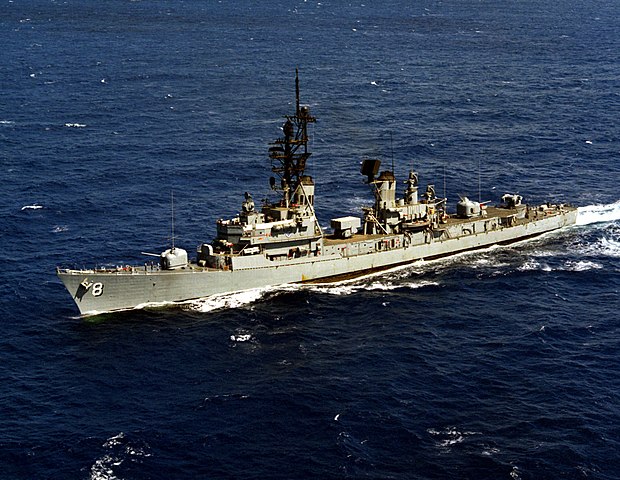
From the same yard, USS Lynde McCormick was commissioned at Boston 3 June 1961 (Commander Ernest S. Cornwall, Jr.) and departed Boston on 23 August 1961 for her home port San Diego. After weapons tests in 1962 at the Pacific missile range she made her fist Western Pacific (WestPac) deployment from 19 November 1962, provisionally homeported to Yokosuka from December and joining the 7th Fleet task group. She was back to San Diego on 15 June 1963. For the second WestPac she was sent in the Gulf of Tonkin after the incidents of 2 and 4 August, screening CruDesFlot 11, for a 6-month deployment, notably escorting USS Bon Homme Richard. She was back home by 6 February 1965 she stayed locally, making a summer cruise to Hawaii training midshipmen and ASW exercises with the Royal Canadian Navy in January 1966 followed by a 3rd WestPac and taking place in the “gunnery line”, firing on vietcong fortfied positions in the Mekong Delta. By May she was at Yankee Station for carrier operations. Back home in late October, she underwent an overhaul at Long Beach until March 1967.
On 17 August she departed for another WestPac, shelling positions by October 1967 north of the DMZ with the heavy cruiser USS Newport News, but rat=rgeted herself by the NV artillery, taking near-misses, as filmed and broactasted in Walter Cronkite’s Evening News. By January 1968, USS Lynde McCormick provided gunfire support during the Tet offensive, until her barrels were so worn out as inoperable. By March 1968 she was in Sea of Japan with the USS Kearsarge battle group, planned to recuperate by force the North Korean hostage USS Pueblo (AGER-2) in international waters. Fast forward.
By June 1982, USS Lynde McCormick fired on Vietnamese fast boats which targeted USS Turner Joy. By 20 July 1983 she served with the USS Ranger Battle Group for another WestPac when reroute for Central America and the coasts of Nicaragua, El Salvador and Honduras for major military exercises. She screened for the USS Ranger and battleship New Jersey, cruiser USS Horne, destroyers Fletcher and Fife andfrigate Marvin Shields, assisted by the oiler Wichita and support ship USS Camden.
In April 1988 she was deployed in the Persian gulf, against the Iranian Navy as part of Operation Praying Mantis between minesweeping operations and repelling small–boat attacks near the Strait of Hormuz. Back home she was eventually decommissioned 1 October 1991, but mothballed, and sunk as target ship on 14 February 2001.
 USS Towers (DDG-9)
USS Towers (DDG-9)
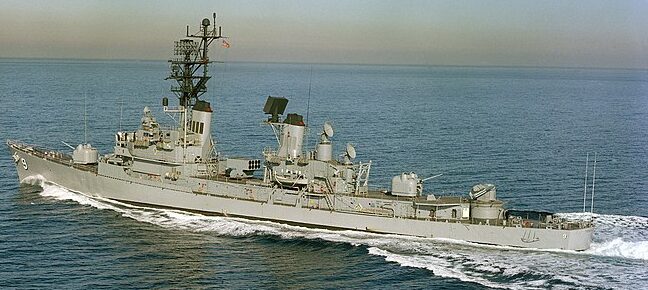
An aerial port quarter view of the guided missile destroyer USS TOWERS (DDG 9) underway off the coast of San Diego
USS Towers was the first of these destroyers built on the Pacific coast, Seattle, Washington, at Todd Pacific Shipyards. She was commissioned on 6 June 1961 at Puget Sound and homeported at San Diego for trials, shakedown, weapons qualifications and training up to the spring of 1962. For her first WestPac, she represented the US in Australia on 30 April anniversary of the Battle of the Coral Sea. HP Yokosuka she also visited Okinawa, Subic Bay, Keeling, and Bangkok. 18 May 1963 was the start of her 2nd WestPac, until 28 November 1963. She had a first major overhaul at San Francisco. She made her 3rd WestPac from 5 January 1965 preparing for 7th Fleet’s operations in the Gulf of Tonkin-South China Sea. She started on Yankee Station, alternated with SAR patrols, interdiction patrols with Operation Market Time. She was back in June but participated en route in May to Operation Sailor Hat (a blast test).
On January-6 February 1966 she took partt in the bilateral ASW exercize with the RCAN, Operation ButtonhookASW). Next was AAW Operation Gray Ghost in April. Next she returned in the Gulf of Tonkin and trained against motor torpedo boat attacks.
During this TOD she spent 3,266 rounds a week of July along on the “Rung Sat Special Zone.” She also took part on the northern SAR station by August, and under her new CO Stanley Thomas Counts and with USS Wiltsie (DD-716) she was posted in rescue mission, directing helicopters. She was back home in 1967, after a storm delay. She had another major overhaul at Hunters’Point Naval Shipyard and returned to operations by the spring of 1968, and took part in shore bombardment exercises with USS New Jersey. She took part also in “Sea Dragon” operations. After solme tours on the “gunline” she was posted as planeguard on “Yankee Station” for USS Constellation, also taking part in Operation Daring Endeavor south of Da Nang. Later she was escort commander for USS Intrepid and assisted the IV Corps operating. Back on “Yankee Station” she screened for USS Hancock, TG 77.5. She was back home on 4 March 1969.
Her next WestPac started by 7 January 1971 and assisted the stranded USS Roark. She was on the gunline on 8 February and rotated to “Yankee Station” for USS Ranger. She trained home in the spring of 1972 between Gunnery and AAW/ASW exercises and back in Yankee station, acted as plane-guard for USS Midway. She supported the defence of key Quang Tri Province and more missions in support of ARVN troops in July, and Operation Lamson 72, then assisted the Linebacker strikes with TU 77.1.2, dealing with shore batteries. She had her 5-inch guns replaced in Sasebo and was back to the gunline for the ARVN off Huế, Qui Nhon, Quang Tri. She was plane guard for USS Constellation on “Yankee Station”.
Last Vietnam War deployment in 1973 was followed by a refurbishment at Long Bach and local exercices in 1973-1976. By July 1976 she made another WestPac homeported to NS Subic Bay for Exercise “Sharkhunt XVII” with the Taiwanese Navy. She toured the Indian Ocean, to Karachi, Pakistan and took part in “Midlink 76” with the Iranian, Pakistani and British navies, followed by “Multiplex/Missilex-76” with the 7th fleet and ASW exercise “Sharkhunt XX” with the Taiwanese Navy. This was followed after home, by another 7-month WestPac and a large overhaul.
She was redeployed for a WestPac in 1980 and in 1981 ASW exercise with the JMSDF, then operations in the Middle East in mid-April, radar picket ship in the Persian Gulf. By February 1982 she trained again with the JMSDF, notably with the SSN USS Blueback. She screened USS Midway for an operational “tune-up” and Exercise “Team Spirit’82” and shifted to the Ranger Battle Group. That kind of routine went on in 1983 (Team Spirit ’83) with South Korea, and later with the JMSDF (Valiant Usher 83), Cobra Gold ’85, Battle Group Alpha and Valiant Usher ’85, Team Spirit 86 off Korea, CrowEater ’86 off Australia, Team Spirit ’87, Team Spirit 87, Mekar 88 (with the Royal Malaysian Navy) ande Cobra Gold 88 off Thailand. In February 1989 she suffered damage to turbine blades. She toure the Indian Ocean, Persian Gulf and visited Kenya. By early 1990 she mad eher last sorties, screening USS Midway before decommissioned at Yokosuka on 1 October 1990. Stricken on 26 May 1992 she was spent as target, sunk by guided missile frigate USS Sides in SinkEx off California, 9 October 2002. For her Vietnam service she was awared a Navy Unit Commendation, a Meritorious Unit Commendation, and four battle stars.
 USS Sampson (DDG-10)
USS Sampson (DDG-10)
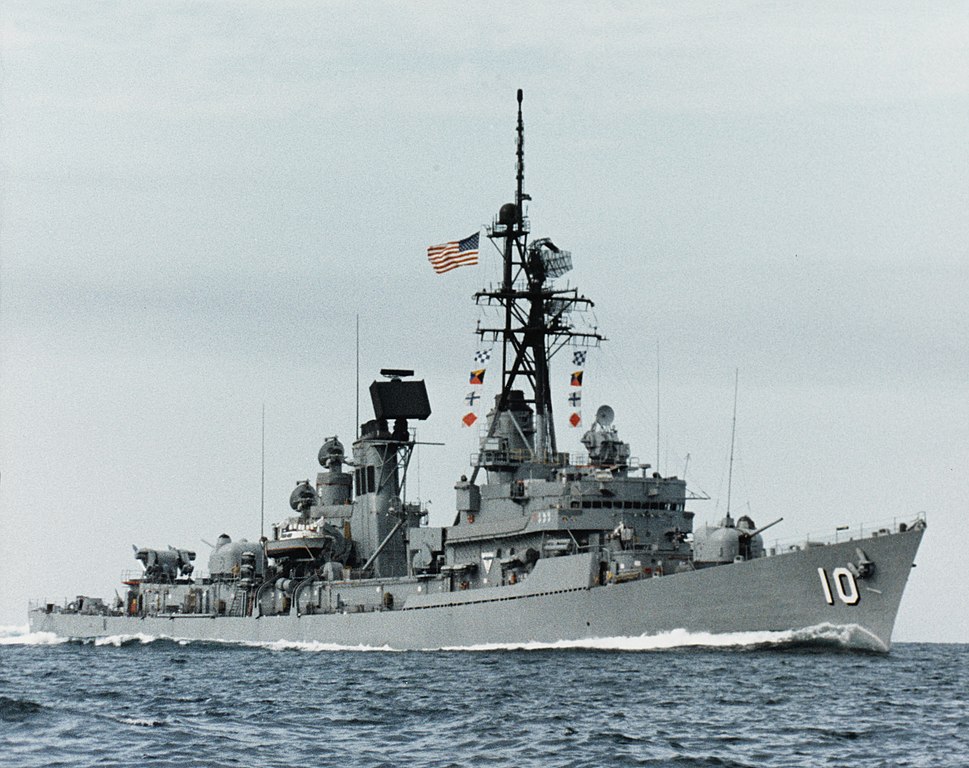
USS Sampson was buult at Bath Iron Works, commissioned on 24 June 1961. After her shakedown off Guantanamo Bay, she tested the Tartar off Puerto Rico and joined her HP Norfolk for more tests and trials before joining DesRon 18, DesDiv 182 this summer 1962. July. Tests and exercizes followed in 1963 and with the Midshipman Training Squadron. By January 1964 she fired two Tartar missiles under simulated combat conditions and was overhauled in 1964, testing a missile replenishment at sea by helicopters.
In January 1965, she started the first of many Mediterranean deployments, delayed by an electrical fire on 14 January and repairs in Norfolk. She served with the 6th Fleet in 1966 and took part in exercise “Lantflex 66” for USS Wasp. She made her 3rd Med TOD by mid-1967 and the Middle East Six Day War in June 1967 saw her reasassigned to USS America CVA-66 task group and TG 60.2 (USS Saratoga CVA-60) under Rear Admiral Geis.
The morning of 2 June 1967 saw her confronting Soviet destroyers trying to disrupt the US carriers formation. She shadowed one until the fleet was in advanced state of defensive readiness. On 8 June 1967 USS Liberty AGTR-5 was attacked by Israeli fighter and IDF MTBs, killing 34 crew members, wounded 171. Sampson assisted USS Liberty on 9 June. She departed home by August 1967, HP Charleston. After her 1969 and 1970 Med TOD she was tasked for special operations in the Mediterranean, with USS John F. Kennedy and Saratoga for a Levantine crisis. In 1971 she trained with the 6th Fleet for six months.
She was in overhaul until May 1972, and for her next Med TOD, homeported to Athens, Greece under command of Richard (Dick) Carson in 1973-1974 and met the Soviet Black Seas fleet at the straits of Bosphurus as the 1973 Israeli/Arab war developed. In 1976 Albert L. Bartels was her new CO and in the 1980s, James F. Chandler, and after a major overhaul in Portsmouth she was deployed in 1982 in the Persian Gulf and Mediterranean. She notably shadowed the Soviet carrier Minsk and cruiser Tashkent in the Indian Ocean, then recalled off Beirut after the US Embassy bombing. In 1984 she took part in Operation Urgent Fury.
By August 1990 she was deployed with USS Saratoga battle group for Operation Desert Shield and Desert Storm. She was the last ship of her class deployed with the Maritime Interception Force, boarding a merchant on 28 august. next she took part in NATO exercizes and patrols off the Suez Canal. She was decommissioned on 24 June 1991, stricken on 20 November 1992, sold, repossessed and only BU by 15 October 2003.
 USS Sellers (DDG-11)
USS Sellers (DDG-11)
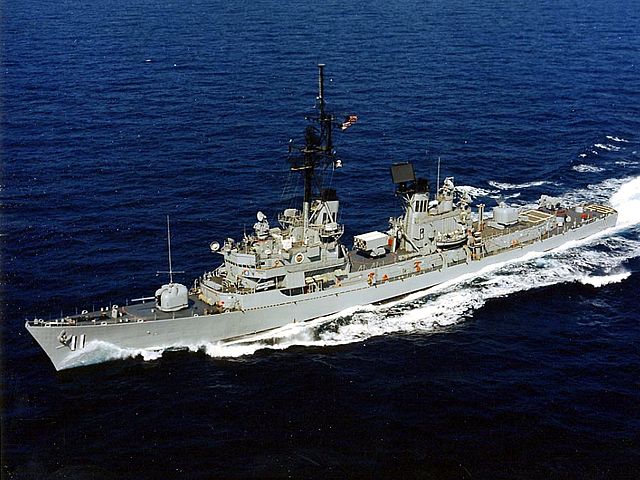
USS Seller was built at Bath Iron Works, commissioned on 28 October 1961. No full records, contact the vets association for this. She was decommissioned on 31 October 1989, stricken on 20 November 1992, sold on 25 July 1995. She was the first and last of the name.
 USS Robison (DDG-12)
USS Robison (DDG-12)
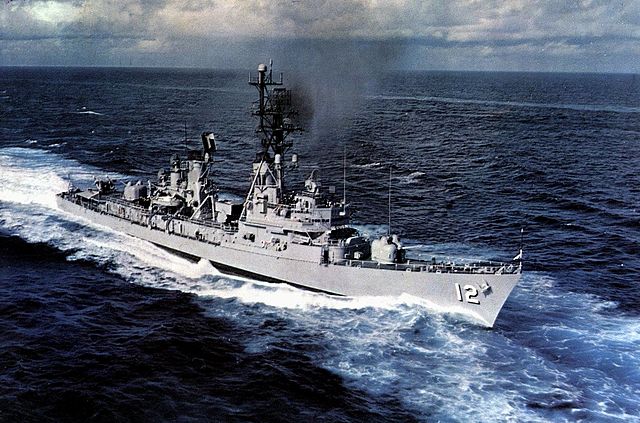
USS Robison was built at Defoe Shipbuilding Co. Bay City, Michigan (Great Lakes), commissioned on 9 December 1961 at Boston. After the usual preparation routine and exercizes she was sent for her frst WestPac. Her combat debut in Vietnam started as plane guard for carriers on Yankee Station, Tonkin Gulf and she took part in Sea Dragon operations, SAR missions and Naval Gunfire and earning 7 battle stars for her service.
She at first served with USS Midway (CV-41) in 1963, USS Hancock (CV-19), HP Yokosuka in 1965. Her Vietnam Operations were udner command of Thomas William McNamara, and she screened USS Coral Sea (CV-43) in 1967-1968, being awarded a Meritorious Unit Commendation. Her 5th WestPac was with USS Kitty Hawk and TG 77.3, and she was made flagship of her division, also for USS Bon Homme Richard. She made three more deployments in 1970-74.
In 1980 she rescued Vietnamese boats people, trained with the Thai Navy and would later receive the Humanitarian Service Medal.
USS Robison was decommissioned on 1 October 1991, stricken 20 November 1992 sold on 20 June 1994 but eventuall sunk off South Carolina for the Marine Resources Division (Department of Natural Resources) for an artificial fishing reef project.
 USS Hoel (DDG-13)
USS Hoel (DDG-13)
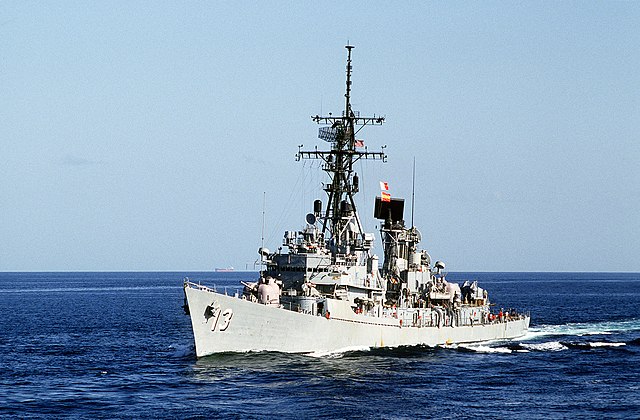
Hoel was built at Defoe Shipbuilding Co;, Commissioned on 16 June 1962 and after fitting out at Boston, HP San Diego, she trained in middle-american waters and off the Canal Zone. Off califoenia she passed her weapons qualifications (ASROC and Tartar) and joined the 1st Fleet, training north as far as Esquimalt, British Columbia, and Pearl Harbor. She was back at San Diego for a Presidential Demonstration held for President John F. Kennedy. After a short refit at Long Beach Naval she departed for the Western Pacific as flagship, DesDiv12.
She alternated the following years between operations with the 7th fleet and off the West Coast (1st fleet).
During ehr 1967 deployment she fired in support of the Corps I some 2,100 rounds and was in SAR duties (plane guard) fur USS Coral Sea.
Fast forward and on 19 October 1987 she took part in Operation Nimble Archer in the Persian Gulf, destroying Iranian oil stations with USS Leftwich, Kidd and John Young, firing nearly 400 rounds during this. Nothing of note for the remainder of the 1980s. She was decommissioned on 1 October 1990, stricken on 20 November 1992, sold on 20 June 1994 but transforced as a Power Barge for the city of Manaus, but the ship was never able to provide what was contracted. She ended BU soon after.
 USS Buchanan (DDG-14)
USS Buchanan (DDG-14)
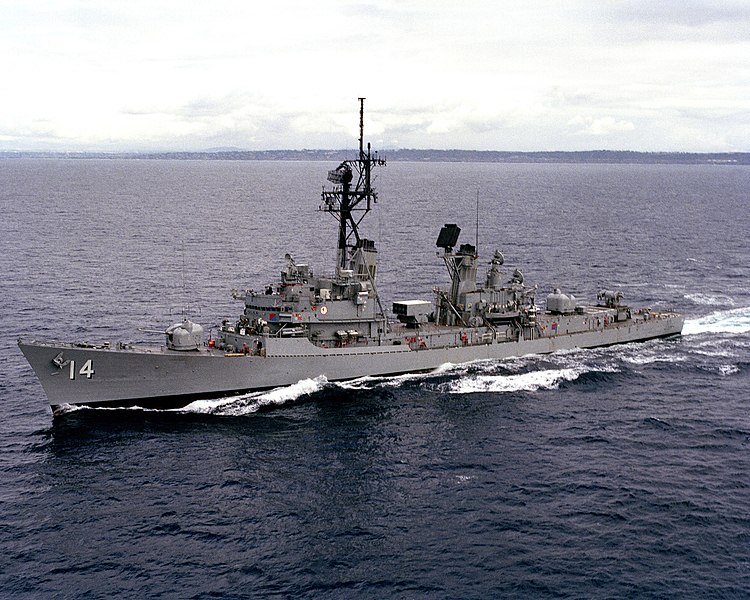
USS Buchanan (after confederate Admiral Franklin Buchanan) was built at Todd-Pacific, Seattle, commissioned on 7 February 1962. After outfitting at Puget Sound she was HP San Diego and flagship, DesRon 15, CruDivFl 7, 1st Fleet, West Coast. On 25 May 1962 she made her shakedown cruise and started training at Pearl Harbor. She started her first western Pacific (WestPac) tour in 1963. She started with TF 77.3.1 (USS Coral Sea, DD USS Southerland and Hanson) for a commemoration in Sydney. She was with TG 77.6 in Guam and Subic Bay, visiting other asian ports and testing her Tartar missiles in the Okinawa Missile Range. She was soon redeployed in the Mekong River to American citizens after a coup in Vietnam by General Dương Văn Minh.
Vietnam War service started by January with USS Chevalier, Rowan and Black at Subic Bay and USS England, Dale, Hamner, Wiltsie, and Chevalier for patrol and plane guard services in the South China Sea. By March 1965 she assisted the landings at Da Nang and later supported air strike operations.
In 1966 she took part exercise “Gray Ghost” and made a 6-month WestPac in Dixie Station for USS Intrepid, Yankee Station off Da Nang and North Vietnam in alternance.
However during the night of 14 September 1967 USS Buchanan collided with the large fishing vessel Holiday. The investigation determined Buchanan in its right, but she had he to be repaired anyway, at Hunters Point until 20 December 1967 and stayed in San Diego before her 1968 WestPac.
She took part in Operation Sea Dragon and alternated with naval gunfire support during the Tet Offensive and Battle of Huế, sustaining shrapnel damage on her ASROC launcher. She was also plane guard in Gulf of Tonkin for USS Kitty Hawk, Enterprise, and Ticonderoga, America and Bon Homme Richard. The same repeated in 1969 but 1970 was calmer, between tender duty with Samuel Gompers and Dixie. 1971 saw her in the eastern Pacific with USS Midway to assist exercizes with SSBN USS John C. Calhoun, and Hawkbill before and overhaul at San Francisco.
Her 1972 WestPac awas with USS Kitty Hawk and she assisted defence during the PAVN Easter Offensive, covering SVN 57th Regiment at Gio Linh. In 1972 she shelled Vinh in North Vietnam with USS George K. Mackenzie and Hamner later repelling an attack by Shanghai-class motorboats, damaged by an airburst.
She made another WestPac from July 1973 in the Gulf of Tonkin as escort, AA picket ship and back home by February 1974.
She made another WestPac in 1944 with USS Constellation and John S. McCain, having a replenishment span wire incident. Later she took part in “MAULEX 3–77” and “MULTIPLEX 5–77”, “SEA SIAM VI”, “MULTIPLEX 7–77”, “ASWEX J1-78”.
She spent 1978 along the California coast and made another WestPac in 1979 followed by an overhaul in San Diego and Long Beach and another WestPac in 1981-82. She had an availability period and new overhaul in 1983 and took part in RIMPAC ’84, followed by another WestPac and a 1985 visit request refused by New Zealand due to her potential nuclear-tipped ASROCs. The US soon announced they suspended the ANZUS treaty obligations. She made another WestPac in 1986 and 1987 but was sent in the Persian gulf during the Iran–Iraq War, patrolling the Strait of Hormuz and taking part in Operation Earnest Will with USS Ranger battle force.
She made her last WestPac via the North Arabian Sea and another rour of ‘Earnest Will’ by June 1989 and returned to San Diego, eastern Pacific operations then drug interdiction patrols, TS for the SEAL and decommission, towed to Hawaii on 15 October and stricken on 20 November 1992 to be sunk as target off Hawaii on 14 June 2000 by Hellfire, Harpoon and a laser-guided bomb but scuttled in the end as she resisted all the pounding.
 USS Berkeley (DDG-15)
USS Berkeley (DDG-15)
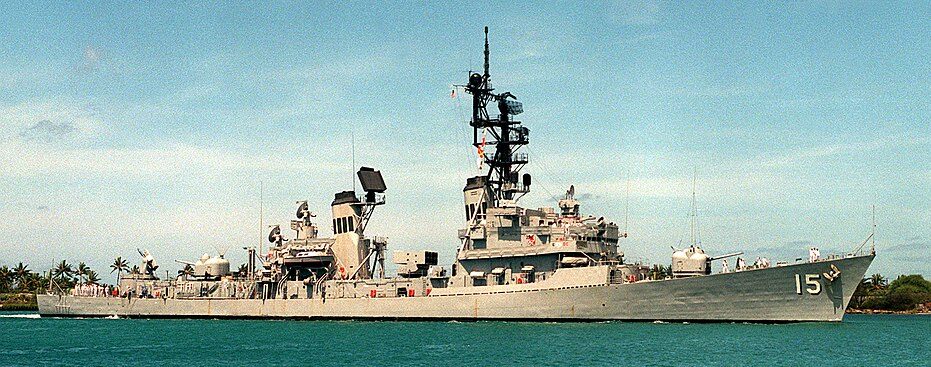
USS Berkeley was buuilt by the New York Shipbuilding Corp. (second batch), commissioned on 15 December 1962 at Philadelphia Nyd, HP Long Beach, for her sea trials, shakedown, and Tartar tests. She showed her capabilities in front of President John F. Kennedy by downing two jet drone targets. She was assigned DesDiv 12. In March 1964, she departeed to join the 7th Fleet in the Pacific. She screened the carriers Kitty Hawk and Ticonderoga. Redirected to the Gulf of Tonkin she screened Ticonderoga this summer and the Tonkin Gulf incident. Next she screened USS Bon Homme Richard. She spent the rest of the year at Long Beach in training and upkeep and returned to another yearly WestPack deployment in 1965, 66. She was assigned notably to TF 77 for Operation Rolling Thunder and Operation “Sea Dragon” and the usual plane guard, SAR and gunline missions as her sisters.
She served also with TU 77.1.1 and more deployments in the 1970s, and until 1973. She would be awared 11 battle stars for her Vietnam service.
After an upgrade she trained with the RCAN in 1974 but returned in teh Pacific to show the flag and train with the Pakistani, Iranian, and British navies, took part in Exercise “Sharkhunt XVI”, and others, received new upgrades notably to operate the Tomahawk missiles, made a brief crisis deployment after the South Korean President Park Chung Hee assassination, and was deployed in the Persian gulf after the American embassy storming in Tehran. Nothing much to signal for the next years but Exercise “Team Spirit 84.” and her participation in the Iran–Iraq War CentCom’s mission in the Middle East. Northing of note for 1987-88, she made more WestPacs, notably with USS New Jersey and TG 70.1 off South Korea and at Pusan, and trained with the RAN. She took part in “PacEx ’89”.
By February 1991, she joined the Coast Guard for a law enforcement mission off Central America, counternarcotics patrols. She was decommissioned at San Diego on 30 September 1992, strucken on 1 October 1992 but transferred to Hellenic Navy as Themistoklis.
 USS Joseph Strauss (DDG-16)
USS Joseph Strauss (DDG-16)
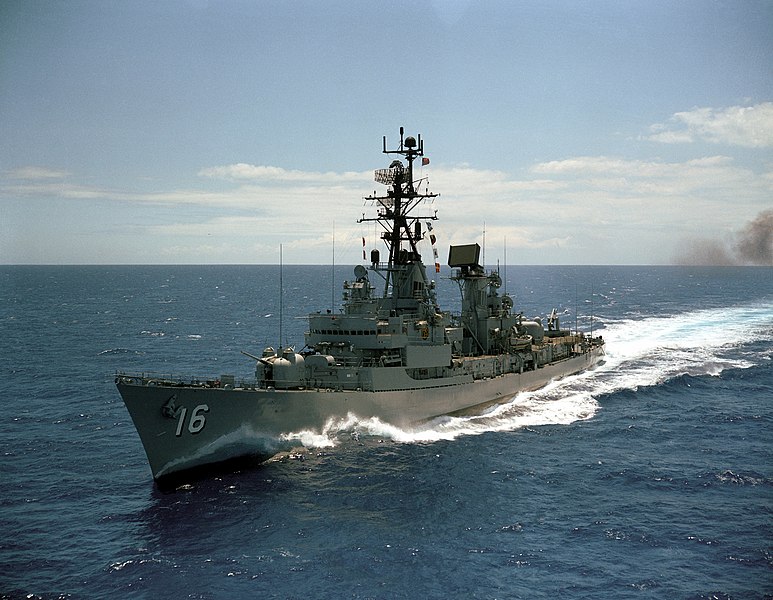
USS Joseph Strauss was built at New York Shipbuilding Corp., commissioned on 20 April 1963, made a short shakedown in the Carribean, and crossed the Panama Canal to join her station at Long Beach having alterations, and follwoed by exercizes. She became flagship, DesRon 3, and was deployed by June 1964 to Pearl Harbor and Midway Atoll, sailing to NS Yokosuka, learning there of the attack on USS Maddox in the Tonkin Gulf. She was sent in the South China Sea via Okinawa, joining USS Constellation, Kearsarge and Ticonderoga. She also took part in SAR/AAW picket missions in the Gulf of Tonkin, showing excellent proficiency and decorated by the Secretary of the Navy.
In 1965 she screened USS Bon Homme Richard and Oriskany and later supported a combined ARVN-Marine Corps search-and-destroy operation.
Fast forward and USS Joseph Strauss too part in Operation Praying Mantis with USS Enterprise in 1988. After sighting three mines floating close, and she nearly escape but eventually struck a submerged mine which alsmot broke her in two. Fortunately her crew stabilized her and she was patched, then sent back to home for long repairs. During Praying Mantis she sank two Iranian warships in the the first surface-to-surface missile combat of the USN.
The action freatured the Iranian Kaman-class FAC Joshan, and Iranian frigate Sahand, sunk by Joseph Strauss Harpoon missiles after a fire and explosion. Sabalan was disabled by a laser-guided bomb. After decommission on 1 February 1990, the destroyer was transferred to Greece on 1 October 1992 as Formion stricken on 11 January 1995, redecommissioned in July 2002 and sold on 19 February 2004.
 USS Conyngham (DDG-17)
USS Conyngham (DDG-17)
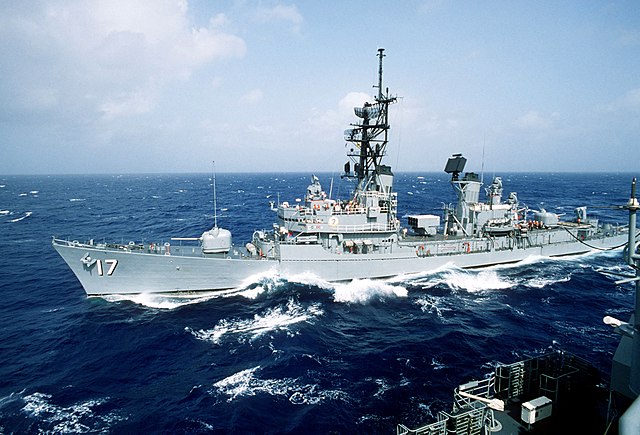
USS Conyngham was also built at NyC Shipb. Co Camden, commissioned on 13 June 1963. She had 27 years of commissioned service sporting the motto “Ready to Serve”. Not a Vietnam combatant, the destroyer made 15 Mediterranean deployments including three to the Persian Gulf, seven to Northern Europe, and the remainder to the Caribbean. She took part in the Cyprus crisis in 1964 and 1974 covered an evacuation at Amman, Jordan in 1970, the contingency operations of the 1973 Yom Kippur war, evacuation from Beirut in 1976, Black Sea Freedom of Navigation operations in 1979
She operated off the coast of Libya in 1982, providing naval gunfire and off Beirut in 1983, and monitores traffic off Nicaragua in 1983. She screened USS America (CV-66) during the intervention in Grenada in 1983. In 1986 she made four drug ship captired, earning a Coast Guard Meritorious Unit Commendation Medal.
She policed merchant shipping in the Persian Gulf (Iran-Iraq War, 1987 Operation Earnest Will). She assited USS Stark (FFG-31) damaged by Exocets launched by Iraqi F-1 Mirage. In 1988, she was deployed in Norway and Ireland.
Her 15th Mediterranean deployment eaned her a four Battle Efficiency “E” in 1989, the last with USS Theodore Roosevelt (CVN-71). On 8 May 1990, she suffered however a fire off the Virginia coast due to leaking fuel oil. The fire ravaged her aluminium superstructure and was hard to extinguish. Due to her age and general state it was decided to have her decommissioned, on 20 October 1990, stricken on 31 May 1991, sold on 15 April 1994.
 USS Semmes (DDG-18)
USS Semmes (DDG-18)
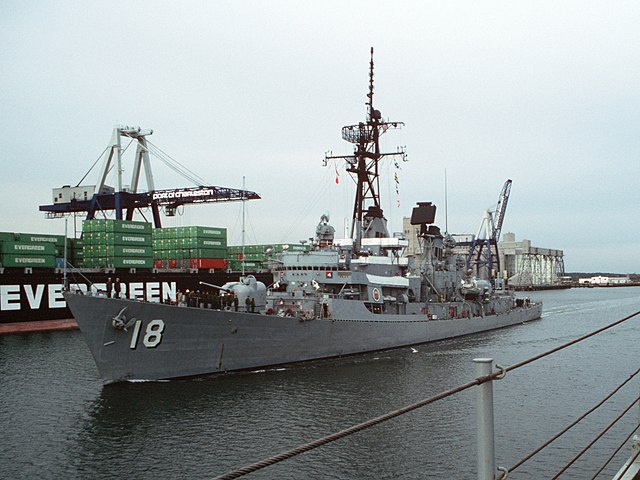
USS Semmes was built at Avondale Marine Ways in Louisiana, commissioned on 10 December 1962. She made her sea trials and shakedown and joined DesDiv 62, DesRon 6, homeported to Charleston by July 1963. The next summer she took part in fleet exercises. September 7, 1964 saw her departure for NATO “Masterstroke/Teamwork” in the North Atlantic and Norwegian Sea, and she crossed the arctic circle on 22 September. By 28 November, she made her first Mediterranean TOD for four months with the 6th Fleet. Back home she took part in the 2nd Fleet exercises (spring 1965) and support operations off the Dominican Republic.
February-July 1966 saw her back with the 6th Fleet and when back, she was homeported to Norfolk by August and she was overhauled. After her Caribbean refreshing the summer saw her with DesRon 6 at Charleston and her 3rd Med TOD with fleet and NATO exercises, and she came back on January 1968. June 1968 saw her back in the Med but also visiting Germany and Denmark before joining again the 6th Fleet, relieved on 15 November by her sister USS John King at Rota, Spain. January 1969 saw her taking part in “Springboard” exercises off Puerto Rico and the Caribbean for 2d Fleet exercises.
1970 saw her making her 7th Med TOD with the 6th Fleet. on 10 February 1970, while moored at Naples, she was struck by the Greek freighter SS Mautric but damage was quickly repaired. She was relieved in Barcelona by USS Conyngham. 1971 had the same routine but she trained with Netherlands and Denmark for bi-national/NATO operations. By January 1972 at Charleston NyD her engineering plant was modified to the Navy Distillate Fuel Oil System. By late 1972 she took part in NATO “Strong Express” off the Arctic Circle, and she visited Norway and Denmark.
In January 1973 she started her 8th tour from Portsmouth, England and a new NATO exercize. For 7 months she cruised the Atlantic and took part in NATO “Sunny Seas”, MARCOT 2/73, and “Midnight Sun” and was versed again to the 2d Fleet.
In November-December 1974 she took part in “Fun in the Sun” and LANTREADEX 2–74 and after reaching Charleston on 19 December she was overhauled. No record for her late career. USS Semmes was eventually decommissioned and stricken on 14 April 1991, sold to Greece on 13 September, renamed Kimon, decommissioned on 17 June 2004, BU 2006.
 USS Tattnall (DDG-19)
USS Tattnall (DDG-19)
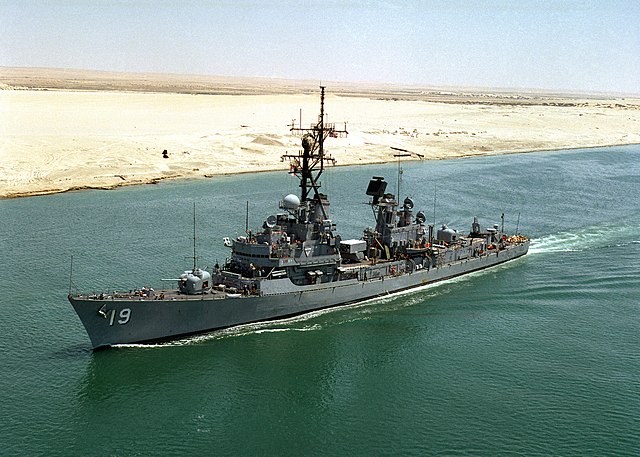
USS Tattnall was built at Avondale Marine in Louisiana, commissioned on 13 April 1963 at Charleston, made her sea trials, tested her Tartar and ASROC systems off Puerto Rico and made her shakedown training in the Carribean. After training she was ready by April 1964 and on 8 September participated in the NATO Exercise “Teamwork” in the Norwegian Sea, Bay of Biscay. She visited other ports and was back to Charleston. She departed for the western Atlantic on 7 December and first Mediterranean deployment, 6th Fleet, back in March 1965.
Back home, the CNO prepared her to conduct Fleet Research Project Number 69 until 7 May and later D/S 336 for combat readiness followed by 0/S 102 by October. She departed for her 2nd Med TOD by February 1966, with Exercise “Fairgame IV” and gatheting intel of Russian warships, exercise “Deep Six” and back on 22 August, followed by a major overhaul in Charleston until 7 March 1967. She departed for her 3rd Med TOD in July, but also participated in “Kiel Week” celebration. By late 1969 she took part in NATO Operation “Peacekeeper.” She was in Mayport where she came back on 10 December 1969.
In 1970 she assisted in tests conducted at Randle Cliffs, Md., by scientists of the Naval Research Laboratory. By September 1971 she departed Charleston for northern Europe, Exercise “Royal Knight.” and returned for a new Med TOD by March 1972, but shifted to the 2nd Fleet HP Mayport by September. On 29 May 1973 she took part in joint American-French exercise off Charleston. Later she made her first UNITAS deployment to South America. She was back in July 1974.
She departed in November for another Med TOD and “special operations” in December. She made many exercizes and was back to Mayport on 6 June after. Sge later moved to Rhode Island in August for training midshipmen. After a regular overhaul in Philadelphia in October 1975, until August 1976, she hosted on 20 September a Cleveland television station news crew. and later took part in exercise “Caribex 2–77” until February 1977 followed by another Med TOD and back on 21 October.
In 1978 she was in the 2nd Fleet “Ready Alert Group” and worked with USS Dwight D. Eisenhower (CVN-69) followed by a deployment in the North Atlantic and with DESRON 12 worked on mine warfare. It was followed by a deployment woth the Standing Naval Forces, Atlantic (SNFL).
She toured northern Europe and took part in NATO exercise “Northern Wedding” and was back home in December.
She was visited by the Navy Inspector General on 19 January 1979 and later joined USS Independence (CV-62) for a week of exercises and completed her Technical Proficiency Inspection but assisted a fire on 8 April on USS Manley (DD-940) while in Mayport. After a midshipman training she took part in Exercise COMPTUEX 3–79 and became flagship for DESRON 26.
She made later the first of several deployments to the Middle East, starting with the Iranian Hostage Crisis (she would also earn six Battle Efficiency Awards in 1979) and joined TG 60.2 for MULTIPLEX 1–80. She passed through the Suez Canal and relieved USS Claude V. Ricketts (DDG-5) for the Arabian peninsula and Persian Gulf, jloining the Middle East Force flagship La Salle (AGF-3).
In 1981, under command of Captain P. T. Deutermann she embarked Vice Admiral Small, CIC 6th Fleet in Egypt and joun TG 70.9 in the Indian Ocean. After exercise “Gonzo 1–81”, but hit an uncharted object while transiting Suez Canal and had her starboard propeller repaired into Malaga and Mayport.
By July 1981, she took part in “Ocean Venture” followed by a 15-month overhaul, equipped notably with the Harpoon and NTDS.
She departerd on 29 September 1983, for anothjer Med TOD, this time off Lebanon, firing on Syrian anti-aircraft positions but on 24 January 1984, suffered a fire erupted and was repaired in Naples and then Mayport on 24 February. Back home, she took part in the opening of the Tennessee-Tombigbee Waterway celebrations.
By late October 1985, she crossed the Suez Canal and relieved Lynde McCormick (DDG-8) in the Persian Gulf and made an exercize with the Pakistani Navy in the north Arabian Sea. Back home she embarked Commander DESRON 12. and worked for ComNavSurfLant.
By January 1988, she had fleet exercises with a dual-carrier battle group off Puerto Rico and returned to the Atlantic and Mediterranean, Gibraltar, NATO exercise “Dragon Hammer”. Back home on 19 January 1989, she needed an overhaul and upkeep. She mebarked Commander DESRON 12 for exercizes but made another Med TOD deployment with NATO countries for NAVOCFORMED and operation “Dragon Hammer” then Operation “Flashing Scimitar” and support for the operation Desert Shield.
Scheduled for deactivation, relieved by Sampson (DDG-10) she was decommission on 18 January 1991, stricken on 12 January 1993 and mothballed in the Inactive Ships Maintenance Facility in Philadelphia, sold on 10 February 1999, and scrapped in Brownsville.
 USS Goldsborough (DDG-20)
USS Goldsborough (DDG-20)
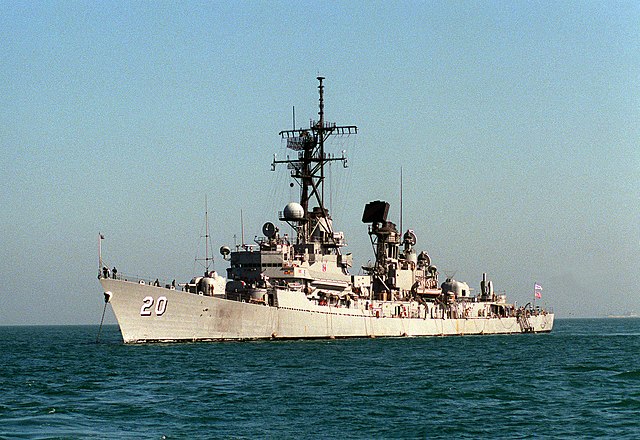
USS Goldsborough off Barhain, December 1986
USS Goldsborough was commissioned on 9 November 1963 with Captain Charles D. Allen, Jr. in command. She was versed to the Pacific Fleet by 25 December 1963, Cruiser-Destroyer Force in Pearl Harbor where but made her shakedown off Puget Sound, and started operation off Hawaii by February 1964. On 18 April she sailed for Sydney, Australia (Coral Sea celebration) and back. By 23 November she made her first Westpac, HP Yokosuka. With the 7th Fleet she made her first TOD off Vietnam after ASW training. By June 1965 she took part in the Gemini IV Program as recovery ship.
By February 1966 she returned with the 7th Fleet, brought gunfire support for Operation Binh Phu I and screened attack carriers at Yankee Station. Took part in SEATO exercises in May, stationed in Hong Kong in June, then picket ship off Vietnam, and back to Pearl Harbor. While in November 1965 she had an accidental discharged of one anti-submarine torpedo, hitting the pier.
August 1966 saw an overhaul and modification, followed by 1967 Operation Sea Dragon and Gunfire Support along the DMZ in Vietnam. She fired 10,000 rounds in support, being awarded the Naval Unit Commendation. by November 1968 she made her 4th WestPac and 88 gunfire missions.
In 1969 she took part in the Apollo 11 Recovery Mission. Her fifth West-Pac tour started in February 1971 with more Gunfire Support for the ARVN and carrier escort duties in the Gulf of Tonkin. September 1971 saw her sixth WestPac with more Naval Gunfire Support and escort and early 1972, recovery Task Force Apollo 16. October 1972 saw her 7th WestPac and last “gunline” in Vietnam. On 19 December she was hit by coastal artillery fire, holed five feet wide on the upper deck (3 kills, many wounded). She was given a Meritorious Unit Commendation for 1972-1973.
By mid-1976 she left Singapore for Shellback initiations, and Indian Ocean training with the Ranger Task Force and Operation Entebbe, for 30 days showing the flag.
Nor records for the late 1970s. By November 1982 she had a seaman killed in heavy seas (Hurricane Iwa) off Hawaii.
In 1988 she was in battlegroup Carl Vinson (CVN-70) for Operation Earnest Will in the Straits of Hormuz and Persian Gulf. She receibd the NTU upgrade and took part later in the Eastern Patrol Area (SOHEPA) off Iranian borders. She later visited Thailand, Hong Kong, and Subic Bay and was damaged by Typhoon Roy.
USS Goldsborough was decommissioned and stricken on 29 April 1993, sold to Australia on 17 September for parts and training maintenance personnel with the pennant 40 on the bow, but never commissioned. After equipment had been stripped, she was towed for BU in India from August 1994.
 USS Cochrane (DDG-21)
USS Cochrane (DDG-21)
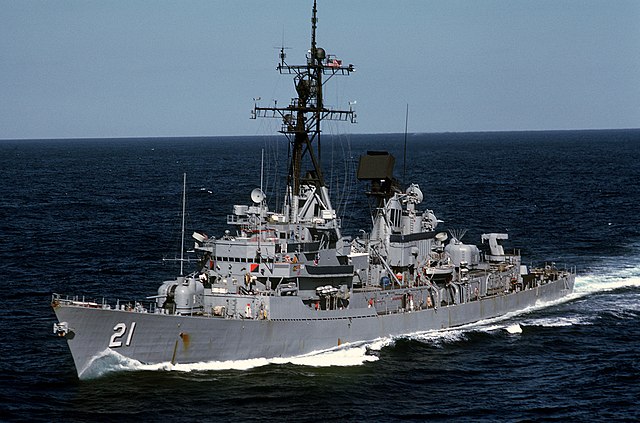
A port bow view of the guided missile destroyer USS COCHRANE (DDG-21) underway.
USS Cochrane (after Vice Admiral Edward L. Cochrane, USN) was built at the Puget Sound Bridge and Dredging Company, Seattle, Washington commissioned on 21 March 1964. In April 1975 she participated in Operation Frequent Wind (the evacuation of Saigon) and on 1 October 1980 she rescued 104 Vietnamese refugees off Saigon. She was decommissioned on 1 October 1990, stricken on 20 November 1992, sold for scrap by 14 November 2000. Full records unavailable.
 USS Benjamin Stoddert (DDG-22)
USS Benjamin Stoddert (DDG-22)
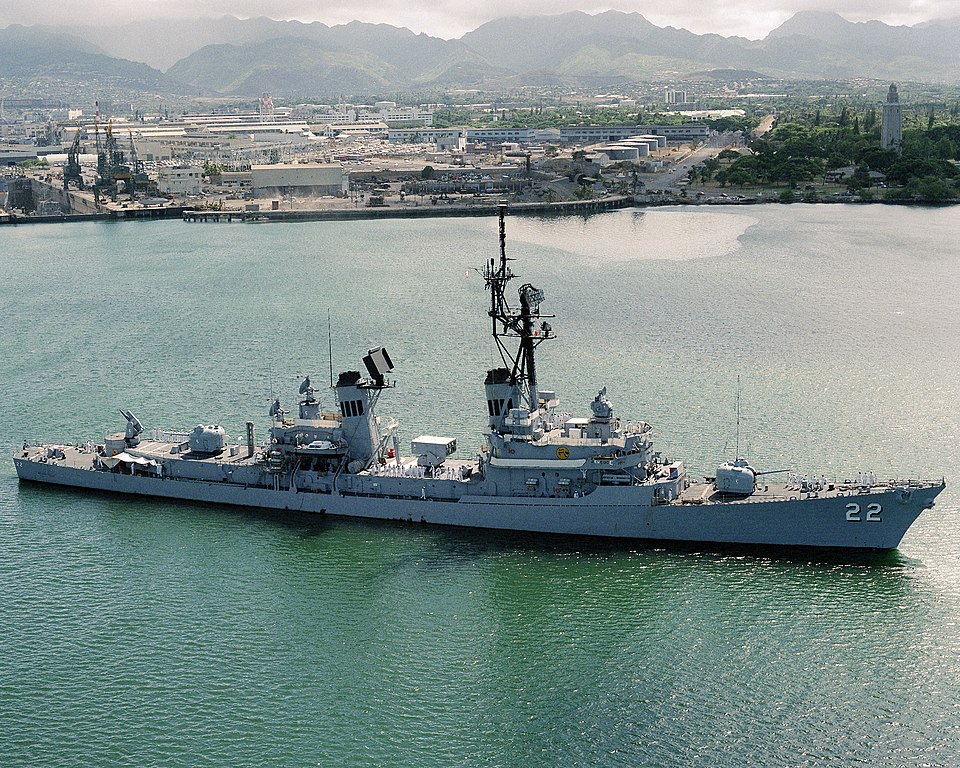 An elevated starboard bow view of the guided missile destroyer USS BENJAMIN STODDERT (DDG 22) leaving port.
An elevated starboard bow view of the guided missile destroyer USS BENJAMIN STODDERT (DDG 22) leaving port.
Built at Puget Sound USS Stoddert was commissioned on 12 September 1964, fitted out made her sea trials from November at Pearl Harbor, tested her weapons systems, and made her shakedown training, before being accepted by the Pacific Fleet Command in August 1965, assigned to DesDiv 112 for local operations and soon her first tour of duty with the 7th Fleet (WestPac). She screened USS Hancock (CV-19) in the Philippines and South China Sea, joining operations off Vietnam.
At “Yankee Station” she joined TF 77 for Operation Rolling Thunder and Operation Sea Dragon at the gunline, aletrnated with the usual picket duties and SAR. She later had to repair broken steam blower before departing Japan and resumed screening Hancock. She also visited Hong Kong. She later visited for the first time Australia and New Zealand from HP Subic Bay and took part in the annual “Coral Sea Celebration” before being back to Pearl Harbor in May 1966.
She took part in the the Gemini 10 recovery, made an exercize and as back to retreive another unmanned Apollo capsule. She was back in Vietnam on 6 April. to screen USS Bon Homme Richard (CVA-31) in the Gulf of Tonkin and made a “Sea Dragon” patrol. In may she had a broken forced-draft blower repaired. She would later suffered a boiler tube failure and was repaired in Yokosuka and later Pearl Harbor. In January 1969 she trained with USS Enterprise (CVAN-65) and USS Rogers (DD-876) and took part in “STRIKEX 1-69” before another WestPac.
She was notably sent for emergency operations in the Yellow Sea and gathering intel on radar and other installations in the Shantung province, eastern China.
She was in “Yankee Station” this summer and used as PARPRO picket ship gatehting later intel off the Korean peninsula. She also served at the gunline off South Vietnam, Chu Lai area, Danang, spending 5,000 rounds.
In January 1970 she was in pearl Harbor taking part in the Barking Sands Tactical Underwater Range (BARSTUR) exercize and training before another WestPac with her sister Goldsborough (DDG-20) at “Yankee Station” for USS Bon Homme Richard and (SAR) in the Gulf of Tonkin relieving USS Bainbridge (DLGN-25) plus BARCAP operations and north SAR station, suffering a fire in her forward fireroom and later a boiler pipe cracked. She served at the gunline off Chu Lai and SAR at “Yankee Station” and back to Pearl Harbor in February.
She served with DesRon 33 but on 29 October a fire broke out in sonar control and it need four hours to be controlled. She was soon back in the Tonkin Gulf for gunline operations and joined TU 77.1.0 for Operation Freedom Train.
When having signals from an enemy fire-control radar she launched two surface-to-surface missiles but they missed off 50 yards to starboard and she took enemy gunfire but returned double salvos. This unique duel lasted for about 13 minutes before the unknown NVA ship withdrew.
She operated later off Thanh Hoa and dealt with shore batteries being hit in her windlass room, the fire destroying her medical storeroom and degaussing cable. She also provided cover for the ARVN, point firing 1,009 rounds. She was back to patrols and gunline operations after a resupplmy at Subic Bay. On 26 June the forward 5-inch mount suffered a misfire and the shell exploded, killing two, mortally wounding two others, and badly damaging the gun mount and nearby spaces. Until that point she had fired 10,476 rounds. Next she served with TU 70.8.9 off North Vietnam until back to Pearl Harbor. While prepared for anouther WestPac a cease-fire agreement was signed on 27 January 1973.
For her Vietnam service she earned nine battle stars, Combat Action Ribbon & Meritorious Unit Citation 1972 WestPac.
She still operated in the Gulf of Thailand during a domestic crisis with TG 76.4. for evacuations and was back in the Gulf of Tonkin for patrolling off Vietnam. On 30 October she suffered a boiler breakdown and was repaired in Subic Bay.
By November 1974 USS Benjamin Stoddert made her 6th WestPac and Exercise “Tae Kwon Do IV.” then “show the flag” operations notably on the Indian Ocean and visiting Mombasa, Kenya. During the North Vietnamese “Easter” offensive in South Vietnam she was sent to Vung Tau, with an amphibious ready group and Military Sealift Command (MSC) ships for evacuations. She rescued 19 from a boat and later 158 refugees from a Korean fishing vessel. She witnessed the fall of Saigon.
Back to Pearl on February 1977 she took part in “RIMPAC 77”.
She was reassigned in 1978 to the surveillance of Pacific fleet Soviet nuclear-powered submarines and guided-missile warships from Japan. She took part in exercise “Tae Kwon Do” and visited Australia and New Zealand and ater trained with USS Constellation (CV-64) south of Guam. While in Japan she took part in “BuzzardEx 1–79” but her next srvice was troubled by continued boiler tissues in 1980, spending five months in drydock, notably in San Francisco. She took part in Exercise “ReadiEx 1-82” and made her 9th WestPac, HP Subic Bay, and exercise “Cobra Gold 82” in the Gulf of Thailand.
On 19 June, in company of the Ticonderoga class USS Sterett (CG-31) and two other destroyers in the South China Sea they were shadowed by a Soviet aircraft which dropped 16 flares over Turner Joy (DD-951) while Lynde McCormick (DDG-8) received .30-caliber MG fire from an unidentified ship and she answered. The incident was closed.
In 1983 she took part in Exercise “MidPacTraEx” and exercises with DesRon 17, screening later USS Ranger (CV-61) off California and Central America. She would made another WestPac and overhauled, modernized in 1985-86, taking part in “RimPac 86” followed by a deployment in the Middle East, relieving USS Goldsborough on station in the Persian Gulf, and later herself by Waddell (DDG-24) followed by another WestPac.
She would later train with USS Carl Vinson (CVN-70) battle group and Nimitz (CVN-68) battle group, take part in “RimPac 88”, made another Persian Gulf deployment during the “tanker war” with Battle Group “Bravo”. It was followed by another WestPac from Subic Bay
By March 1990 she made her second Coast Guard law enforcement operation, in Hawaiian waters followed by “RIMPAC 90”. In 1991 she trained with USS Abraham Lincoln (CVN-72) battle group. Decommissioned at Pearl Harbor on 20 December 1991, she was stricken 20 November 1992 and berthed with the National Defense Reserve Fleet in California, later she sank while under tow to the shipbreaker, on 3 February 2001 in the Pacific.
 USS Richard E. Byrd (DDG-23)
USS Richard E. Byrd (DDG-23)
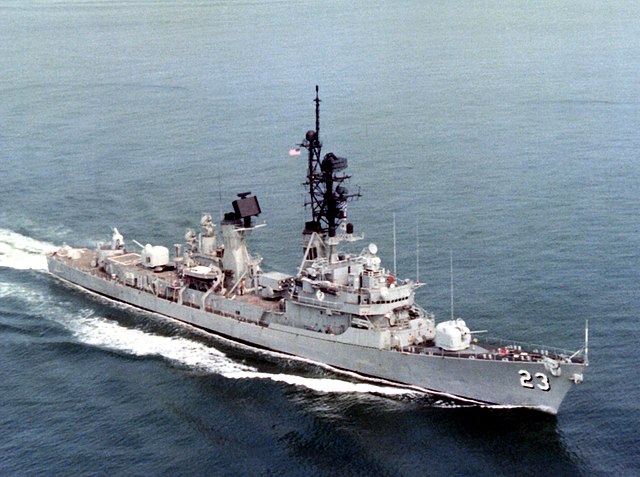
DDG-23 was built at Todd Shipbuilding Corp. in Seattle, Washington and commissioned on 7 March 1964. After a 45-day fitting out at Puget Sound Naval and sea rials she was homeported at Norfolk via the Panama Canal to start shakedown on her way to her forst Med TOD from 6 January 1965 as part of DesRon 182.
By January 1967 she trained off Jacksonville as a rescue destroyer for USS Lexington and later screened USS America, and assisted the damaged USS Liberty on 9 June.
On 6 October 1969 she carried Senator Harry F. Byrd and Virginia Gov. Mills E. Godwin for an homage to Richard Evelyn Byrd Hall at the Virginia Institute of Marine Science, Gloucester Point, Virginia.
On 26 January 1975, while in Corfu, two ship officers were mobbed by 4,000 Greeks, almost lynched, and the local military police intervened, killing one while police and fire trucks escorted them back to the ship. This was max tension during the Cypriot War, the destroyer soon departed.
Early 198 she made a six-month North Atlantic cruise and while in Lisbon, Portugal on 28 January she and other ships moored at Alcantara dock were targeted by mortar fire from the terrorist group Forças Populares 25 de Abril, but there was no damage.
USS Byrd was eventually decommissioned on 27 April 1990, stricken on 1 October 1992 but transferred to the Hellenic Navy on 26 August 1993 but only used for spare parts, never recommissioned.
 USS Waddell (DDG-24)
USS Waddell (DDG-24)
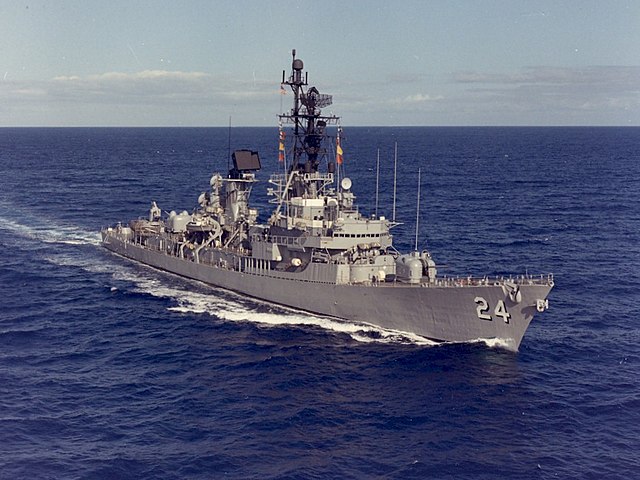
USS Waddell was commissioned and made her sea trials from October 1964 to May 1965, shakedown cruiser off the west coast by July followed by the Exercise “Hot Stove” this summer. She screened USS Ticonderoga and later acted acting as flagship for DesDiv 132 in their first WestPac via Pearl Harbor to the Philippines. She recused the merchantman Tokei Maru. Next she made her first combat deployment in Vietnam at “Yankee Station” W-5, Tonkin Gulf for TU 77.0.2 and northern search and rescue station (SAR) until December.
She toured Sasebo, Okinawa, made exercizes in Ryūkyū waters, visited Hong Kong. On 3 February 1966 she made a shore bombardment at Da Nang, silencing batteries but was straddled by the enemy guns, although she was unscathed.
She collided later with Brinkley Bass, repaired in the Philippines. She provided in February gunfire support for the III Corps for TU 70.8.9. In 1967 after going home for Xmas she made her 2nd eWestpac deployment in Vietnam and by May was congratulated by the command for “exceptional readiness and effectiveness in all tasks assigned”. Her shore bombardments saw her spending 2,000 rounds and she was dubbed by the press “the busiest ship in the Tonkin Gulf” when greeted home, Long Beach. She had an extensive overhaul up to February 1968.
3rd WestPac via Midway, HP Yokosuka from August 1968. Three tours on the “gun line” and screening USS Coral Sea and Ranger. On 22 September she rescued a splashed bomber personal.
New gun line tour on 17-30 January for the 101st Airborne Division, 7th and 9th Divisions ARVN. Same in February and March on the II Corps area, 12 support missions, 79 more gunfire support missions for Australian and ARVN units as well Operation Sheridan.
In April, she was in Tsushima to screen USS Ticonderoga and Ranger and Sea of Japan until the 28th. Next was another gun line missio off Phu Quoc Island, Gulf of Siam for Operation Javelin and Mekong Delta ARVN support. She screened USS Enterprise in June. Waddell received 11 engagement stars for her service in waters off Vietnam and two Navy Unit Commendations. No record for her 1970-90 service. She was decommissioned in 1992, sold to Greece.

 Latest Facebook Entry -
Latest Facebook Entry -  X(Tweeter) Naval Encyclopedia's deck archive
X(Tweeter) Naval Encyclopedia's deck archive Instagram (@navalencyc)
Instagram (@navalencyc)





 French Navy
French Navy Royal Navy
Royal Navy Russian Navy
Russian Navy Armada Espanola
Armada Espanola Austrian Navy
Austrian Navy K.u.K. Kriegsmarine
K.u.K. Kriegsmarine Dansk Marine
Dansk Marine Nautiko Hellenon
Nautiko Hellenon Koninklije Marine 1870
Koninklije Marine 1870 Marinha do Brasil
Marinha do Brasil Osmanlı Donanması
Osmanlı Donanması Marina Do Peru
Marina Do Peru Marinha do Portugal
Marinha do Portugal Regia Marina 1870
Regia Marina 1870 Nihhon Kaigun 1870
Nihhon Kaigun 1870 Preußische Marine 1870
Preußische Marine 1870 Russkiy Flot 1870
Russkiy Flot 1870 Svenska marinen
Svenska marinen Søværnet
Søværnet Union Navy
Union Navy Confederate Navy
Confederate Navy Armada de Argentina
Armada de Argentina Imperial Chinese Navy
Imperial Chinese Navy Marinha do Portugal
Marinha do Portugal Mexico
Mexico Kaiserliche Marine
Kaiserliche Marine 1898 US Navy
1898 US Navy Sovietskiy Flot
Sovietskiy Flot Royal Canadian Navy
Royal Canadian Navy Royal Australian Navy
Royal Australian Navy RNZN Fleet
RNZN Fleet Chinese Navy 1937
Chinese Navy 1937 Kriegsmarine
Kriegsmarine Chilean Navy
Chilean Navy Danish Navy
Danish Navy Finnish Navy
Finnish Navy Hellenic Navy
Hellenic Navy Polish Navy
Polish Navy Romanian Navy
Romanian Navy Turkish Navy
Turkish Navy Royal Yugoslav Navy
Royal Yugoslav Navy Royal Thai Navy
Royal Thai Navy Minor Navies
Minor Navies Albania
Albania Austria
Austria Belgium
Belgium Columbia
Columbia Costa Rica
Costa Rica Cuba
Cuba Czechoslovakia
Czechoslovakia Dominican Republic
Dominican Republic Haiti
Haiti Hungary
Hungary Honduras
Honduras Estonia
Estonia Iceland
Iceland Eire
Eire Equador
Equador Iran
Iran Iraq
Iraq Latvia
Latvia Liberia
Liberia Lithuania
Lithuania Mandchukuo
Mandchukuo Morocco
Morocco Nicaragua
Nicaragua Persia
Persia San Salvador
San Salvador Sarawak
Sarawak Uruguay
Uruguay Venezuela
Venezuela Zanzibar
Zanzibar Warsaw Pact Navies
Warsaw Pact Navies Bulgaria
Bulgaria Hungary
Hungary

 Bundesmarine
Bundesmarine Dutch Navy
Dutch Navy Hellenic Navy
Hellenic Navy Marina Militare
Marina Militare Yugoslav Navy
Yugoslav Navy Chinese Navy
Chinese Navy Indian Navy
Indian Navy Indonesian Navy
Indonesian Navy JMSDF
JMSDF North Korean Navy
North Korean Navy Pakistani Navy
Pakistani Navy Philippines Navy
Philippines Navy ROKN
ROKN Rep. of Singapore Navy
Rep. of Singapore Navy Taiwanese Navy
Taiwanese Navy IDF Navy
IDF Navy Saudi Navy
Saudi Navy Royal New Zealand Navy
Royal New Zealand Navy Egyptian Navy
Egyptian Navy South African Navy
South African Navy






























 Ukrainian Navy
Ukrainian Navy dbodesign
dbodesign
Benjamin Stoddert was not sunk as a targeted. She was being towed for scrapping. About halfway between Pearl Harbor and the Panama Canal, she started taking on water in high seas. The tug crew went aboard to see if they could save her, realized they could not, so they opened all the watertight doors and hatches they could. She rolled over and sank.
Hi Tom, you’re right, fixed, and thanks for the additional info !